Port Lympne Reserve
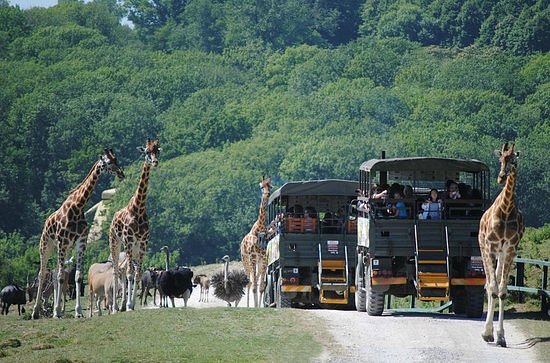

Top ways to experience nearby attractions

Most Recent: Reviews ordered by most recent publish date in descending order.
Detailed Reviews: Reviews ordered by recency and descriptiveness of user-identified themes such as waiting time, length of visit, general tips, and location information.

PORT LYMPNE RESERVE: All You Need to Know BEFORE You Go (with Photos)
- Sun - Sat 09:30 - 18:30
- (0.00 mi) Rhino Lodge
- (0.16 mi) Lympne Castle Cottages
- (0.51 mi) Giraffe Lodge
- (0.79 mi) Treehouse Hotel
- (0.67 mi) Bear Lodge
- (0.12 mi) The County Members
- (0.54 mi) Unit No.1
- (0.39 mi) The Garden Room At Port Lympne Hotel & Reserve
- (2.25 mi) Hide and Fox
- (2.78 mi) Coppers
- (0.13 mi) Hythe Sound Mirror
- (0.18 mi) Lympne Castle
- (2.54 mi) Alpaca Annie
- (2.41 mi) Kent Ballooning
- (0.50 mi) Royal Military Canal, West Hythe

Howletts Wild Animal Park and Port Lympne Reserve
Home to some of the world's most endangered animals, including Kent's only gorillas and black rhino, elephants at Howletts, and many more! Visitors can enjoy a wild day out and see real conservation in action!
Port Lympne is set over 600 acres and is home to the UK's most authentic safari experience. The African Experience - 100 acres alive with animals.
Throughout the year visitors can take advantage of special themed events all included in the price of the ticket at no extra cost! Visitors can also book additional activities for an extra special day, including bespoke safaris, guided tours, team building activites, keeper experiences and many more.
Restaurants and kiosks are located around the park providing a variety of hot and cold snacks.
The Reserve also offers a variety of short breaks, each one offering a unique experience, from an inside view to the lives of tigers or a glamping experience you’ll never forget. Port Lympne Hotel and Reserve can offer it all. Find out more at https://www.aspinallfoundation.org/port-lympne/short-breaks/ .
See website for prices.
Howletts Wild Animal Park and Port Lympne Reserve Port Lympne Hotel & Reserve Aldington Road Lympne CT21 4PD
Opening Times
Open everyday except Christmas Day Port Lympne Summer March - October 9.30am - 6.30pm (last entry 3.30pm) Winter October - March 9.30 - 5.30pm (last entry 2.30pm) Howletts Summer March - October 9.30am - 6pm (last entry 4pm) Winter October - March 9.30am - 5pm (last entry 3.30pm)
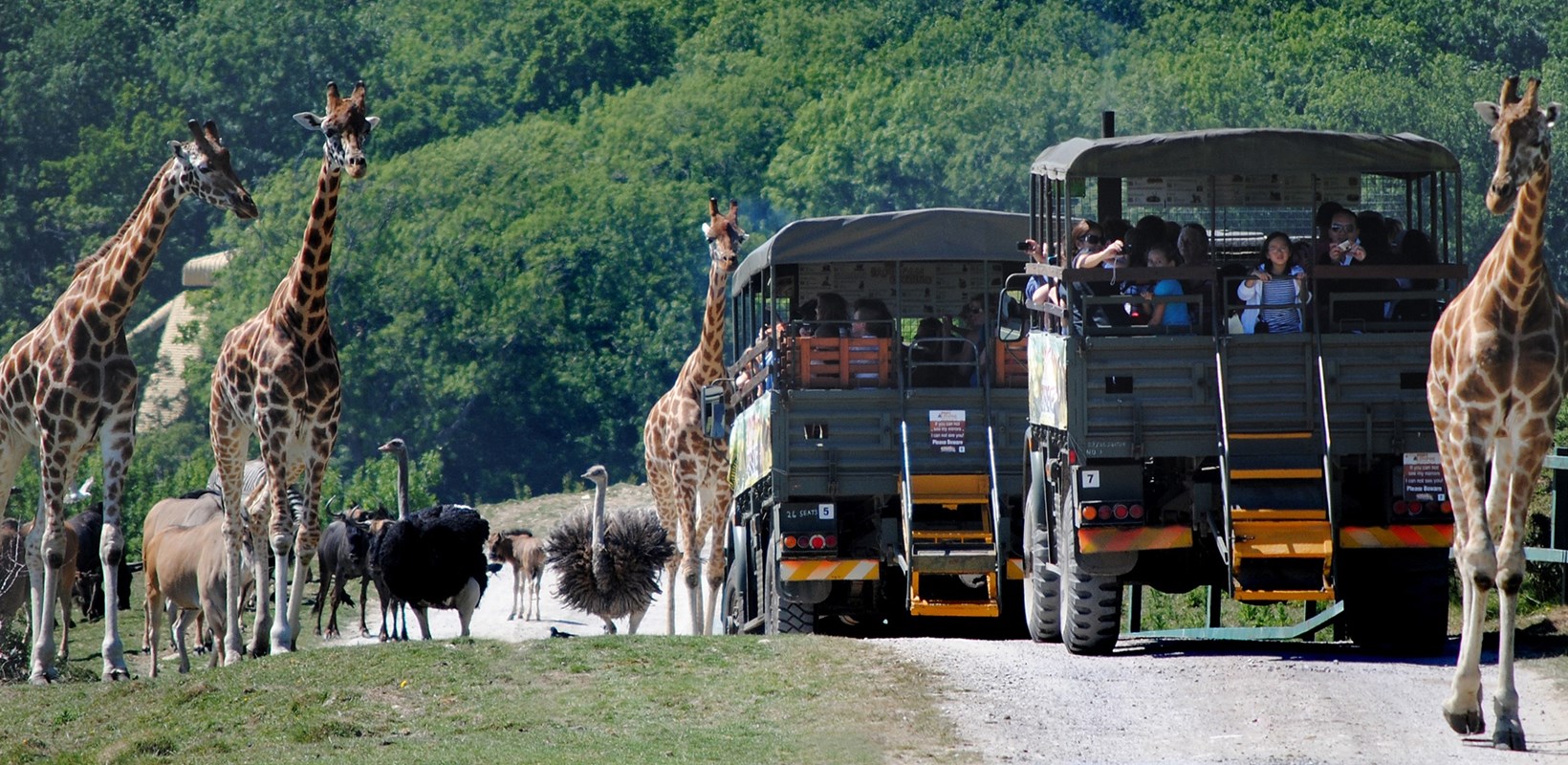
You may also be interested in

Dog-friendly accommodation

Dog-friendly attractions
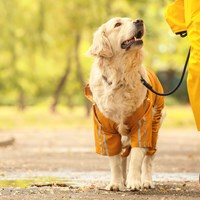
Dog Friendly Walks

Dog-friendly places to eat and drink
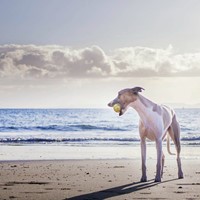
Kent's Dog friendly beaches
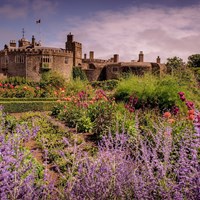
Ways to make the most of spring
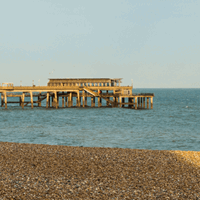
Celebrating Kent's Coast
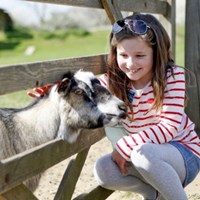
Animal Experiences in Kent
Attractions Near Me
You're 1 click away from serious fun.

Half-Price Port Lympne Animal Park Entry, Safari and Digital Adoption Pack 5/5 (6)
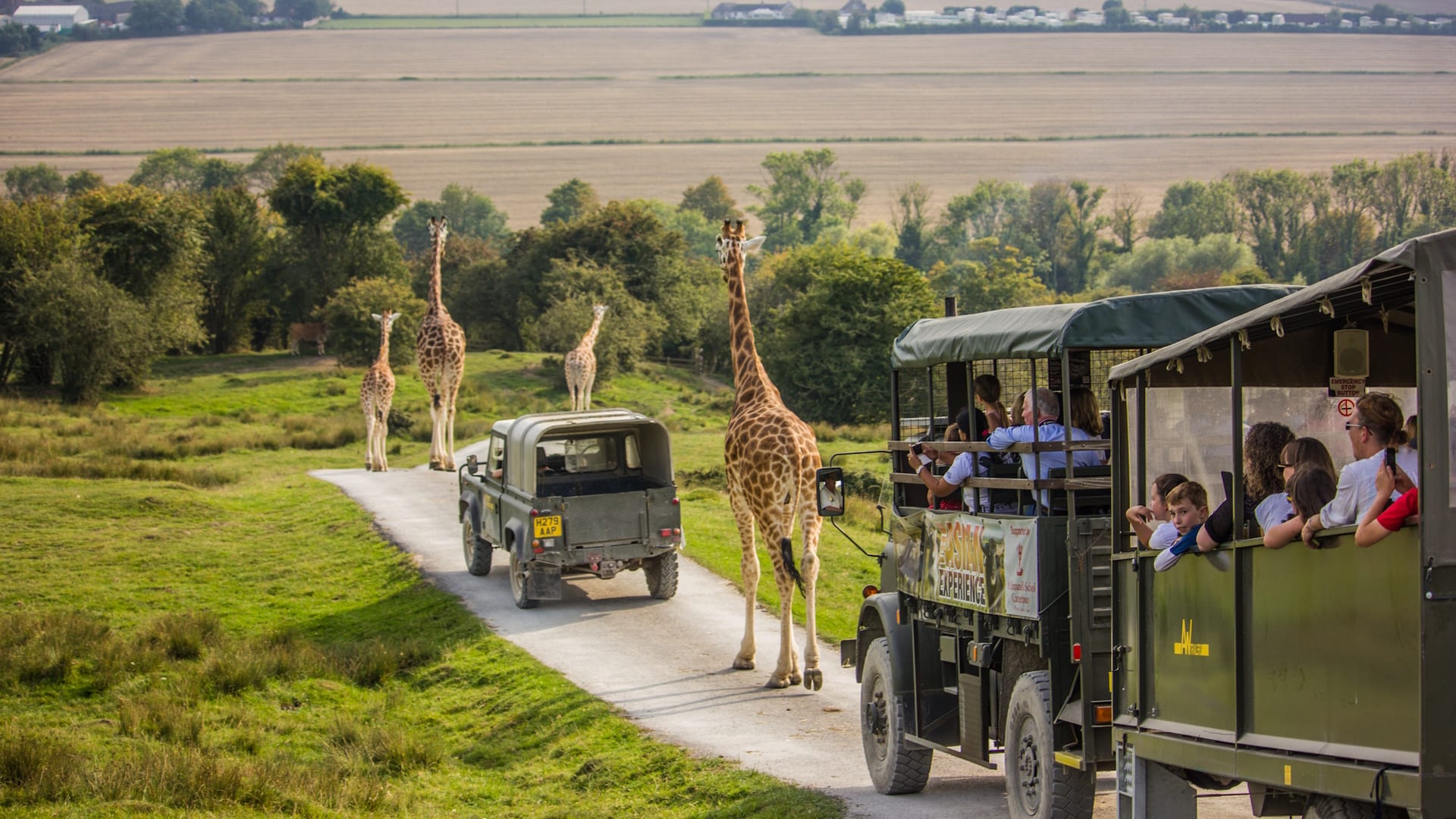
See over 900 animals up close and personal with a half-price day out at Port Lympne Animal Park. This fantastic value package also includes a safari experience and a digital adoption pack.
Admire Hundreds of Rare Animals
If you’re an animal lover, a visit to Port Lympne Reserve including a safari and animal adoption is just the ticket. With a focus on giving the resident animals as much space as possible, spend the day roaming the large site and admiring hundreds of rare animals.
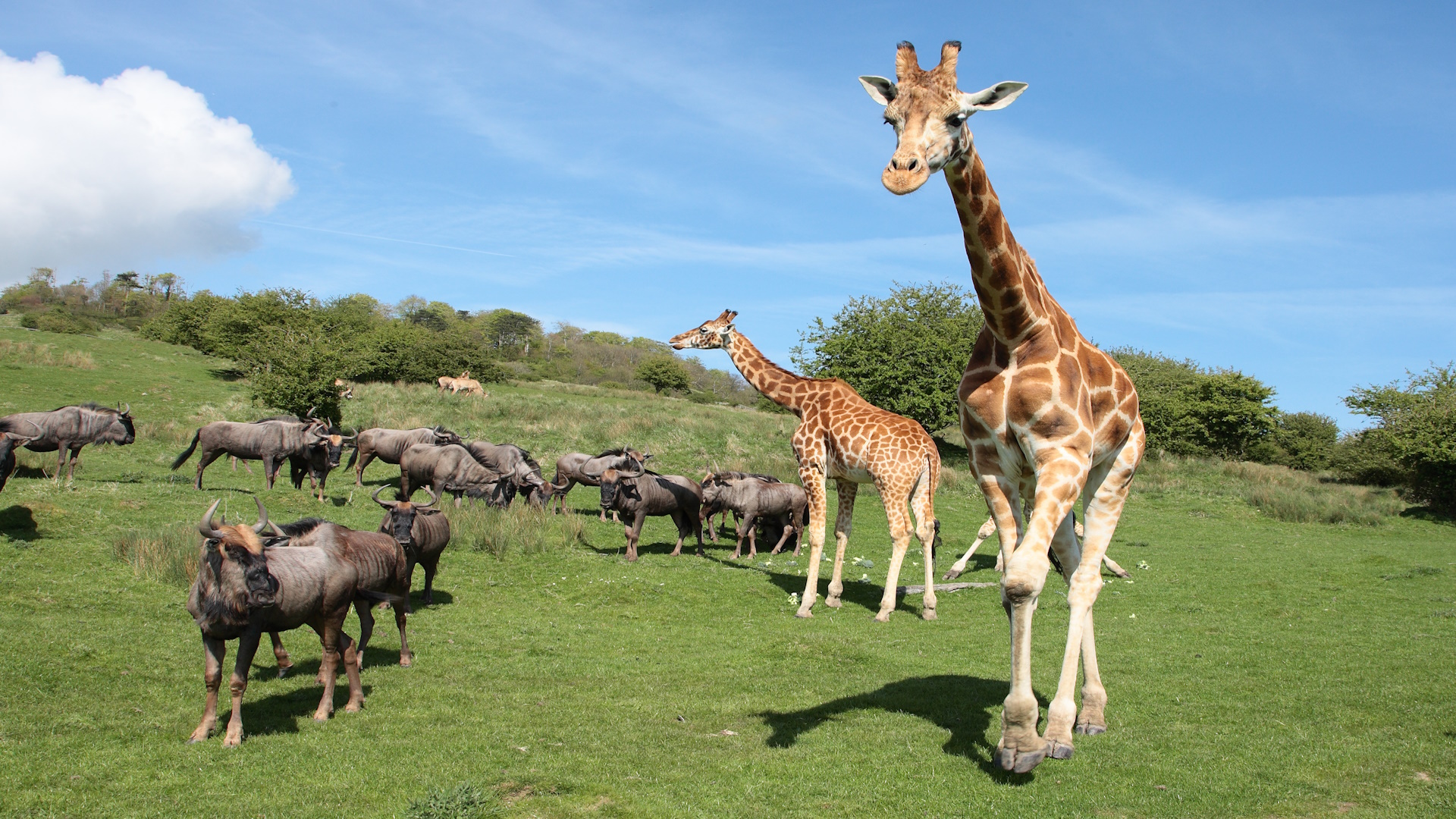
Safari Experience
Continue your adventure on an unforgettable 60 minute truck safari covering hundreds of acres, allowing you to see African and Asian animals roaming freely with expert knowledge from your ranger guide.
Animal Adoption
As part of the package, you’ll also adopt an animal of your choice and receive a digital adoption pack. Your adoption will help The Aspinall Foundation carry out international conservation work, protecting endangered animals and their natural habitat.
What’s Included?
⭐ Animal park: Enjoy a roaring day out with a ticket to Port Lympne Reserve wildlife park with a digital animal adoption pack, as well as an amazing truck safari experience! ⭐ Safari experience: Go wild as you hop aboard the truck and see spectacular South American, Asian and African animals such as bears, giraffes, zebras, camels and more! ⭐ Animal adoption: Remember the day forever with a digital animal adoption pack with a choice of 35 animals. ⭐ Digital adoption pack: Your digital pack will come with a photocard, fact sheet and certificate of adoption. ⭐ Conservation: The park leads the way in animal care, enclosure design, enrichment and breeding success and is designed to be breeding sanctuaries for some of the world’s most rare and endangered animals.
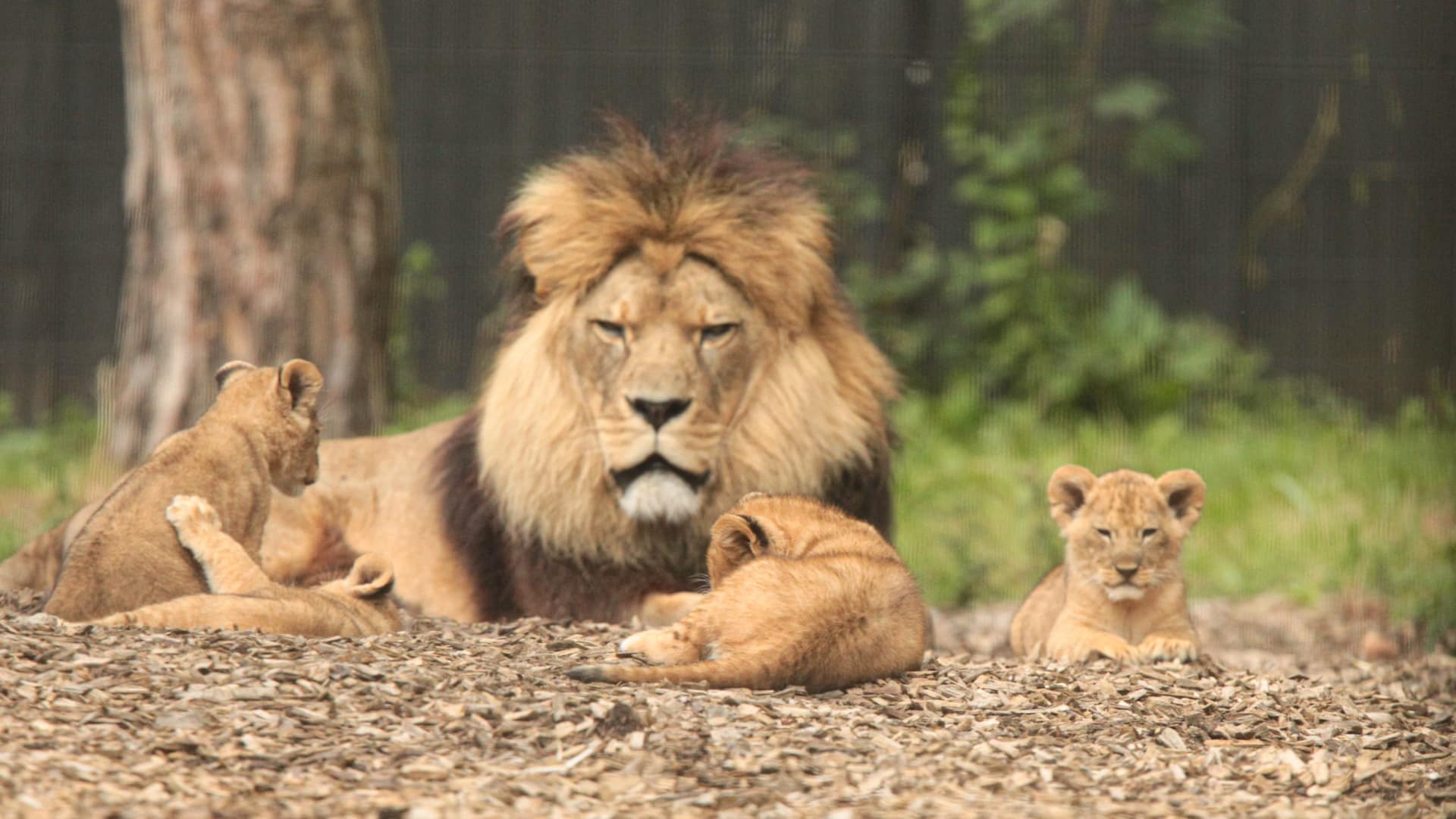
Located in the tranquil, bucolic landscape of south Kent, Port Lympne Reserve is home to a magnificent array of wildlife and endangered species. Go wild and meet some of the beautiful residents – from majestic black rhinos and awe-inspiring Siberian tigers to the pint-size pudu deer, you’re bound to find a favourite.
Immerse Yourself in Wildlife Wonders
Prepare to be amazed as you immerse yourself in the wonders of wildlife at Port Lympne Hotel & Reserve. With over 600 acres of diverse habitats, this reserve is home to a remarkable array of animal species from all corners of the globe. From majestic giraffes gracefully roaming the plains to playful primates swinging through the trees, every step you take will bring you closer to the fascinating world of nature. Embark on a guided safari tour and witness these incredible creatures up close, or explore the reserve at your own pace and let serendipity guide your path. No matter how you choose to experience it, the wildlife at Port Lympne Hotel & Reserve will leave you in awe.
The Aspinall Foundation
Port Lympne Hotel & Reserve is part of The Aspinall Foundation, an internationally renowned animal conservation charity that works in partnership with both Port Lympne and Howletts Wild Animal Parks. Their mission is to halt the extinction of rare and endangered species and return them to the wild where possible.
Travelling to Port Lympne Hotel & Reserve
Port Lympne Hotel & Reserve is located in the South East of England in Kent, and is within easy reach of the home counties of London, Surrey, Sussex, and Essex. You can reach the attraction by car, train and bus.
Travelling by Train
Port Lympne Hotel & Reserve is approximately 60 minutes from London St Pancras on the high speed service, alternatively, it’s 90 minutes from Charing Cross or Victoria Railway Stations. Take the train to Ashford International Station and from there, it is just a short bus or taxi ride to the park. Search for your train tickets using Raileasy .
Nearby Accommodation
There are lots of places to stay in Kent. Find hotel accommodation at Hotels.com or Travelodge are always a good option for good quality, family-friendly budget hotel accommodation.
Check our dedicated accommodation page for more ideas on places to stay or view self-catering cottages available from Snaptrip .
Attractions Near Me Offers
For the best deals and Discount Days Out visit our Offers page Attractions Near Me Also, like our Facebook page for notification of any new offers Facebook.com/AttractionsNearMe
Author: Dan
I am passionate about Theme Parks and Attractions. I love riding roller coasters and thrill rides. With two young boys I understand how expensive family days out can be and this was one of the main driving forces behind Attractions Near me. My aim is to help you and your friends enjoy some great days out without costing the earth. Thanks for reading and have a great time - Regards Dan
Your Opinion
Related pages.

Share this:
- Click to share on Twitter (Opens in new window)
- Click to share on Facebook (Opens in new window)
- Click to share on LinkedIn (Opens in new window)
- Click to share on Pinterest (Opens in new window)
Leave a Reply Cancel reply
You must be logged in to post a comment.
Half-Price Port Lympne Animal Park Entry, Safari and Digital Adoption Pack
Privacy Overview
Change location, find awesome listings near you.
Port Lympne Safari Park
Buying as a gift lovetovisit gift card available here, 25% off port lympne safari park tickets - pick your safari truck ride time for the ultimate kent day out for families.
Port Lympne Safari Park is home to over 600 acres of wildlife wonderland and over 900 amazing animals for you to discover in an exciting day out for a discounted price in Kent today.
How does my Port Lympne Safari Park ticket work?
- Pick your timeslot for the safari truck ride
- Your tickets also grant you all-day admission to the safari park
- Adult tickets from £24, was £32
- Child tickets from £21, was £28
Book your discount admission tickets to Port Lympne Safari Park in Kent and get ready for an unforgettable day out for the whole family, or read on to find out more about this fantastic Kent day out.
Ticket Information:
The time shown on your ticket is the safari truck start time. It is advised to arrive at the park 60 minutes prior to the safari truck start time. Once confirmed, the safari time will not be able to be amended. The safari loading area is approximately a 15-minute walk from the entrance. If the safari is missed, alternative times will not be offered.
Visit Port Lympne Safari Park for one of the best things to do in Kent with the family
If you're looking for some of the best days out in Kent, then you and the family will love visiting Port Lympne Safari Park. Enjoy an immersive journey into a world of wildlife like no other!
Hop in the safari truck and get ready for an adventure into nature, where you'll meet extraordinary animals from around the world.
Home to wildlife from every corner of the globe, Port Lympne Safari Park lets you witness many majestic animals as they roam free in natural habitats.
Explore the many things to do at Port Lympne Safari Park
Kent's largest wildlife park is home to wonderful animals from all over the world. See wildlife park favourites such as lions, zebras, cheetahs, giraffes and monkeys, while also encountering rare animals that have become endangered in the wild, such as the Western lowland gorilla, the Eastern black rhino and the Siberian tiger.
These are just some of the many exotic animals that you'll find on your safari adventure through Port Lympne! The whole family will love spotting animals of all shapes and sizes as you make your way through the site on a safari truck ride.
Conservation is at the very heart of Port Lympne Safari Park, and each visit to the park helps fund the protection of these extraordinary animals.
The Aspinall Zoo's are two of Kent's best days out
Kent has two wonderful wildlife parks, both offering locals and visitors to the area fantastic days out in Kent:
- Howletts Wild Animal Park - a walk-through wildlife park with over 300 animals and around 50 species, you'll witness real conservation in action at Howletts Wild Animal Park in Kent
- Port Lympne Safari Park - info on this page
General Admission & Safari Truck Tickets - Port Lympne Safari Park
Get your tickets to a safari truck ride at Port Lympne Safari Park in Kent for 25% OFF and see extraordinary animals from around the world today.
How to find us
Port Lympne is in Lympne near Hythe. Leave the M20 at Junction 11 and follow the brown tourist signs to the park (about 5 minutes drive from the motorway)
How do my Port Lympne Safari Park tickets work?
These tickets include general admission and a ride on the safari truck. The timeslot shown on your ticket is when your safari truck ride will begin.
Once confirmed the safari time will not be able to be amended.
It is advised that you arrive to the park 60 minutes prior to the safari time. Park gates open from 9:30am.
The safari loading area is approximately a 15-minute walk from the entrance.
If the safari is missed alternative times will not be offered.
Is Port Lympne Safari Park wheelchair accessible?
Port Lympne Safari Park is wheelchair accessible. Accesibility facilities in Port Lympne Safari park include:
- Wheelchair and buggie routes
- Accessible toilets
- Accessible restaurant
- Accessible gift shop
- First aiders
- Accessible safari truck
- Wheelchair available to hire
- Mobility scooters permitted
- Minibus assistance available
- Concession tickets available
- Assistance dogs permitted
- Disabled parking
How long should I spend at Port Lympne Safari Park?
It takes around 4-5 hours to explore all of Port Lympne Safari Park.
Can you drive through Port Lympne Safari Park with your own car?
No, your car is left at the car park and you walk through the parks. However, there is an African & Asian Experience safari ride available.
How many animals are at Port Lympne Safari Park?
Port Lympne is home to approximately 900 animals and 75 species.
Can I bring my dog to Port Lympne Safari Park?
Dogs are not permitted at the park, except for registered assistance dogs.
You might also like
Howletts wild animal park.
Meet tigers, gorillas, wolves, leopards and lemurs in their natural habitats at the wonderful Howletts Wild Animal Park in Kent
Wyvernwood - Best Price Tickets
Discover a world beyond our own when you head to the magical land of Wyvernwood, where you can meet fairies, wizards, dragons, and unicorns!
Willows Birds of Prey & Wildlife Trail - Best Price Tickets
Come and see birds of prey in flight as well as a whole host of wonderful animals that call Willows Birds of Prey & Wildlife Trail their home
Dover Castle - Best Price Tickets
Take your family on a trip back to medieval England for a day out you won't forget at Dover Castle
Huckleberry Woods - Tickets
If you're looking for a relaxing experience that will keep the whole family entertained, Huckleberry Woods is a perfect choice! Book your tickets here
Upside Down House in Lakeside - Best Price Tickets
Lakeside's Upside Down House is a strange orange house outside of London, where everyday furniture has been flipped on its head
Maverick Boat Adventures - Best Price Tickets
Get the very best of watersports when you head on a boat tour and go wake-boarding or water-skiing with Maverick Boat Adventures
Colchester Zoo
Discover the animal kingdom at Colchester Zoo in Essex, a true paradise for wildlife and nature-lovers of all ages alike
An Insider’s Guide to Port Lympne Reserve
28 Sep, 2023
Port Lympne Reserve, located in Kent, England, is a renowned wildlife conservation and safari park that covers approximately 600 acres of stunning countryside. Established in the 1970s, the reserve is famous for its mission to protect and rehabilitate a diverse range of wildlife species from all over the world. Visitors to Port Lympne can embark on a safari-style adventure where they can observe animals in settings that resemble their natural habitats. Port Lympne is home to a wide array of wildlife, including large mammals like African elephants, giraffes, lions, and rhinos, as well as smaller creatures such as lemurs and exotic bird species. It provides a variety of educational programs designed to spread knowledge about protecting wildlife and the environment. The picturesque landscape of Port Lympne, with its rolling hills and lush vegetation, provides a beautiful backdrop for this important conservation effort.
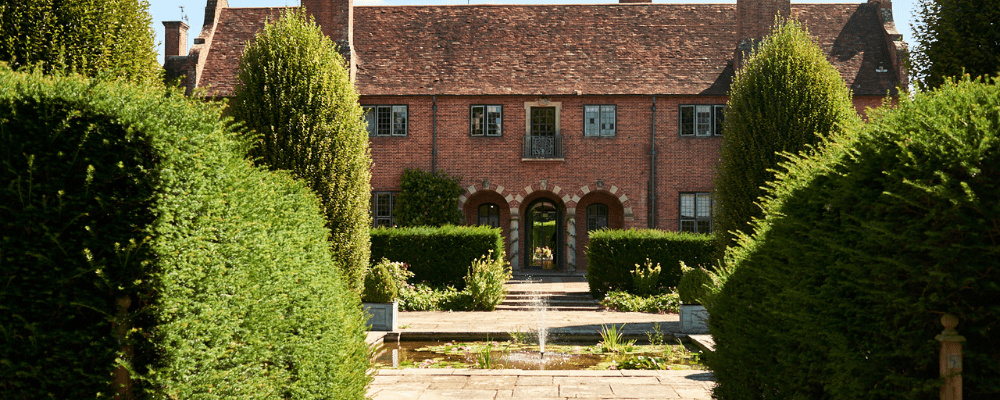
The Gastronomic Experience at Port Lympne
With an array of dining options, visitors can embark on a gastronomic experience that complements the natural beauty of the reserve. Every meal, whether it is fine dining or quick nibbles, offers a chance to discover the essence of this unique location. The reservation offers three restaurants and several other options of food and beverages.
The Garden Room Restaurant
At Garden Room Restaurant, guests can enjoy a seasonal menu made with locally sourced ingredients. With its huge windows and pleasant environment, the restaurant boasts a welcoming atmosphere. Dishes here range from hearty mains to carefully crafted desserts, providing a diverse culinary experience.
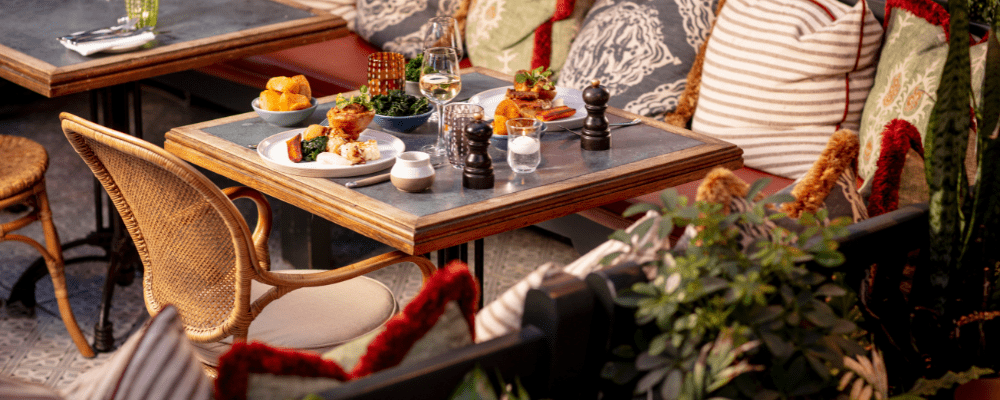
Babydoll’s Wood Fired Pizza
Babydoll’s Wood-Fired Pizza provides casual and family-friendly dining options. Here, wood-fired pizzas with a variety of toppings are prepared to perfection. The atmosphere is relaxed and informal, with a focus on creating a comfortable space for families and groups to enjoy their meals together.
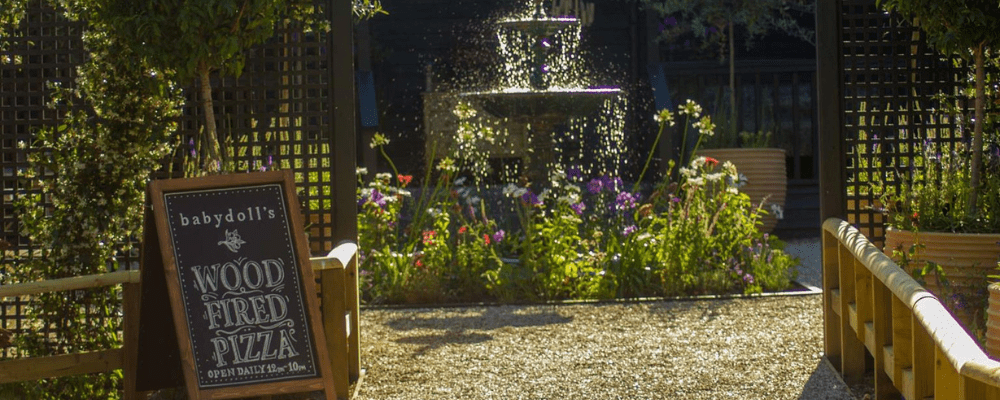
Bear Lodge Restaurant
The Bear Lodge Restaurant is open to those looking for a distinctive place to stay overnight. Amid the gorgeous Kent countryside, it offers a fine dining experience. The cuisine is chosen to suit the realistic safari experience, offering a range of international and locally-inspired dishes.

In addition, the reserve offers several impressive spots. Near the picturesque watering hole, you can find a selection of refreshing drinks and snacks. There are also cafés for a quick pick-me-up, a terrace to enjoy the historic Port Lympne Mansion with a selection of fine wines and cocktails, and a picnic area for those who prefer a more al fresco experience. Finally, Port Lympne ensures that every visitor feels comfortable, offering a variety of vegetarian and vegan dishes.

Accommodations Choices
Accommodation options at Port Lympne Reserve cater to a range of preferences, from luxurious and immersive experiences to more rustic and nature-centric stays.
Luxury Lodges
Each lodge is uniquely themed and provides stunning views of the Kent countryside. The lodges are equipped with en-suite bathrooms, cosy bedrooms, and spacious living areas. Some lodges also offer private hot tubs and balconies, providing an extra touch of luxury. Additionally, guests have the exclusive opportunity to embark on after-hours safaris, adding a touch of adventure to their stay.
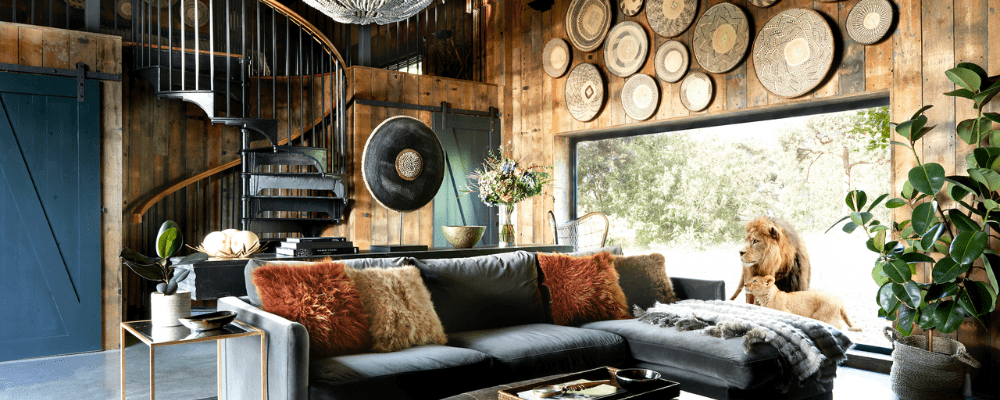

Treehouse Hotel
Elevated among the treetops, the luxurious treehouses offer a unique combination of comfort and adventure. Each treehouse is equipped with en-suite bathrooms, cosy bedrooms, and stylish lounges. The experience is further enhanced by the exclusive use of a golf buggy for exploring the reserve.
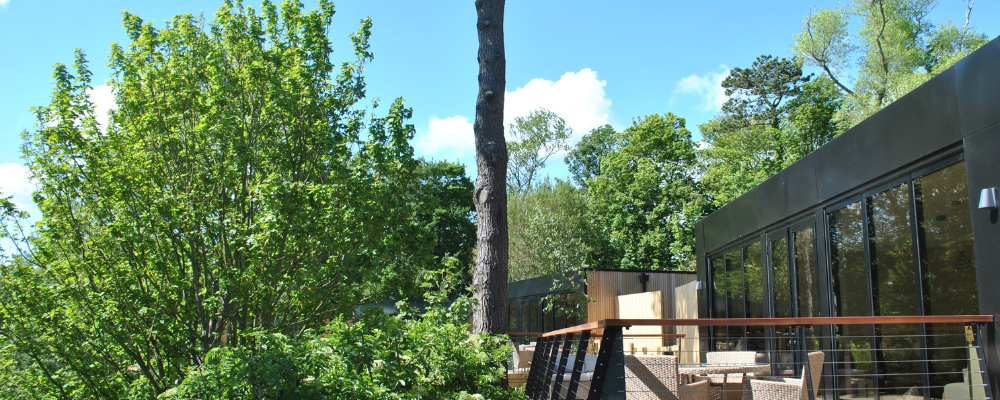
Located centrally in the Port Lympne Mansion, the cottages are the perfect option for guests looking for more privacy. Cottages combine vintage elegance and modern comfort, offering a fully equipped kitchen, comfortable living spaces, and a lovely outdoor terrace. It’s an ideal choice for families or small groups looking for a more intimate lodging experience.
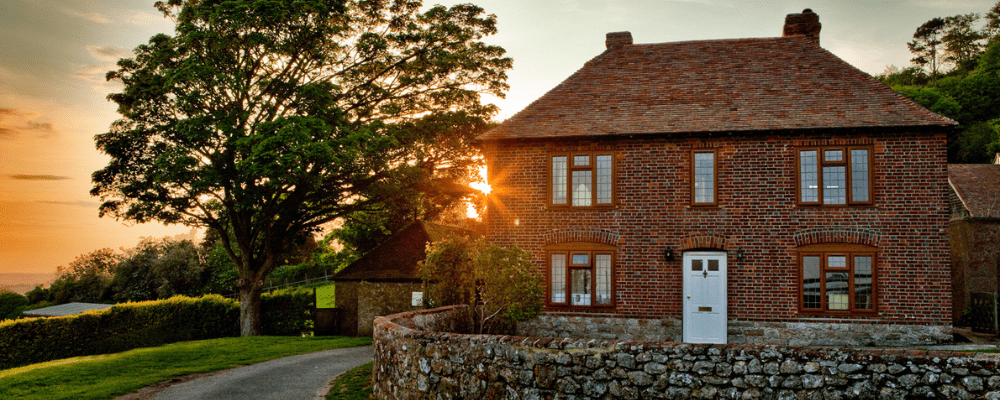
Pinewood Camping Pods
For guests seeking a more rustic and adventurous stay, cabins provide a cosy and back-to-nature experience. The pods offer comfortable beds, heating, and access to shared bathroom facilities. Guests can also enjoy their private decking area, perfect for relaxation and stargazing.
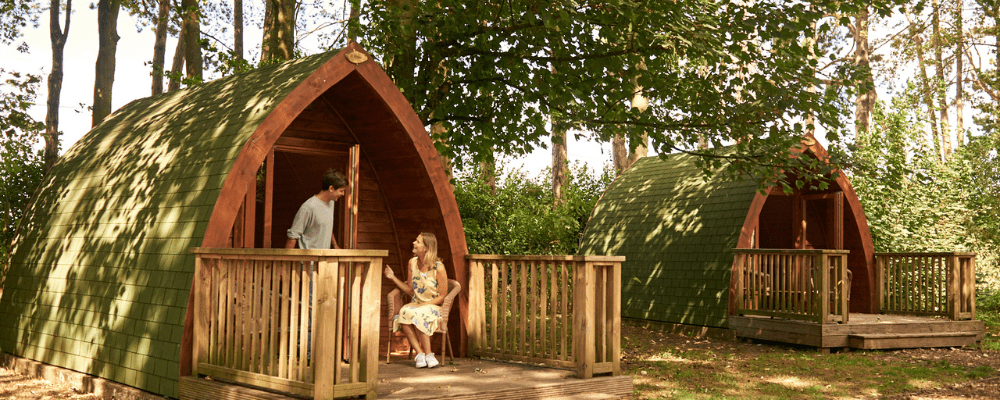
Offering 180-degree panoramic views, the bubble is the ultimate romantic getaway. The accommodation can host two guests. With transparent walls and ceilings, it includes a freestanding bath, as well as a monsoon shower, and a separate living area.
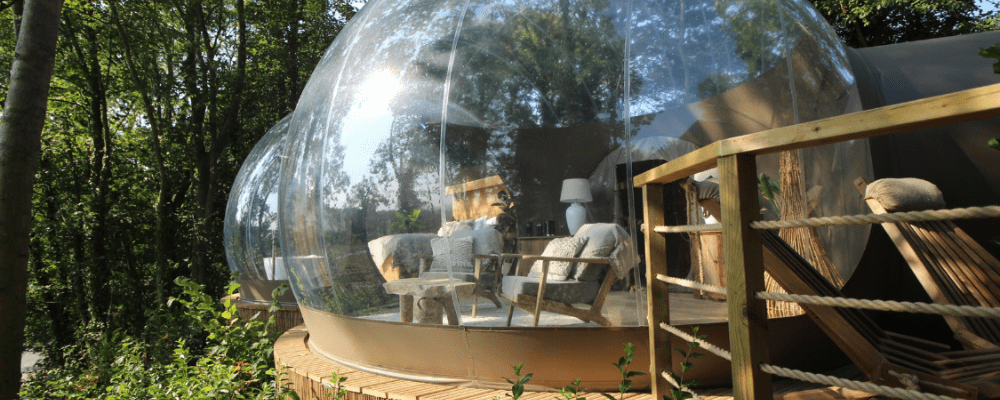
This is the perfect destination for nature enthusiasts, families and anyone looking to support wildlife conservation !
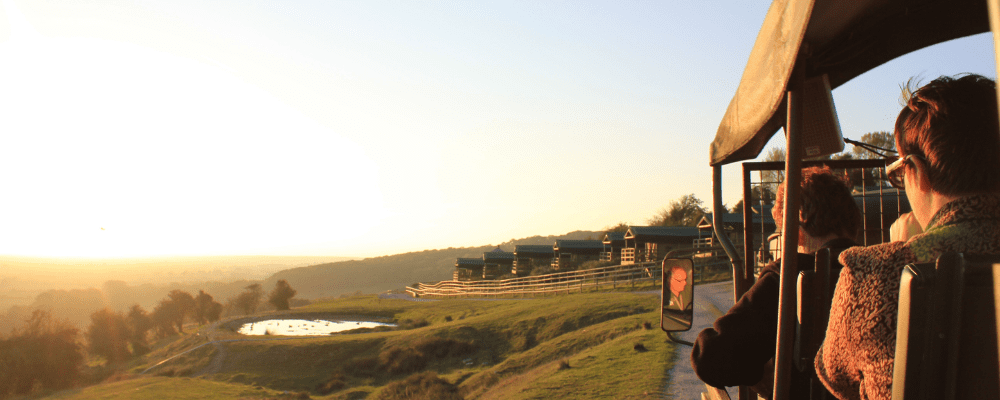
Tags: England , Kent , reserve , restaurants , safari , Travel guide
Privacy Overview
Join our mailing list to stay up to date on our top travel tips and giveaways.

Our Day At Port Lympne Safari Park and Wild Animal Reserve REVIEW
This year I have started to hear about Port Lympne. A safari park and wild animal reserve in Kent. Who also offer amazingly different short break experiences. I couldn’t believe that there is a safari park in Kent giving you the full safari jeep experience. The only time we had ever experienced something like that is in Disney’s Animal Kingdom , I didn’t know it was an option in the UK. We were offered the chance to visit for the day to review the park, I couldn’t wait to take the children there.
*This post contains affiliate links. As a TradeDoubler Member, I earn from qualifying purchases.

We love sharing our days out on our blog. Make sure you visit our Days Out and Experiences post to read all about them.
Join Days Out With The Kids VIP Pass * for exclusive discounts on days out and travel. You will be able to unlock over 1000 offers on lots of top UK attractions.
Visiting Port Lympne
Port Lympne works extremely closely with the Aspinall Foundation. They are a conservation charity who are leading the way in the reintroduction of captive-bred animals back into the wild.

Port Lympne is home to Kent’s only giraffes and spectacled bears. Gorilla feeds are a real highlight of any visit and take place at 12 and 3 pm. They also have a Dinosaur Forest that is the UK’s largest outdoor dinosaur exhibition.
The reserve covers 600 acres and is home to more than 760 animals from over 90 species. It is split into two areas, the safari truck routes, and the pedestrian routes. It has a combination of hilly and flat terrain. This can sometimes be steep and uneven.
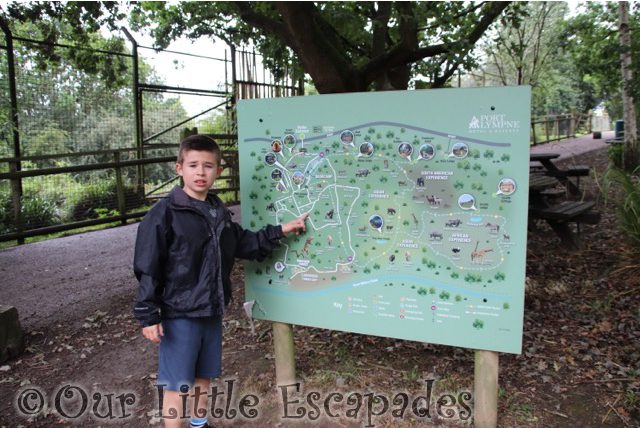
If you are interested in a short break at Port Lympne there are over 13 different ways to stay there. Including glamping, the hotel, a stay in a bubble or a tiger, wolf or rhino lodge.
The Safari Experience
Upon entering Port Lympne we were directed to Basecamp. This is where the truck stop is to join the safari. We got there just after opening and wanted to make this our first port of call to avoid any long queuing times. As soon as we arrived at the truck stop a truck arrived for us to board with the group of passengers already waiting.
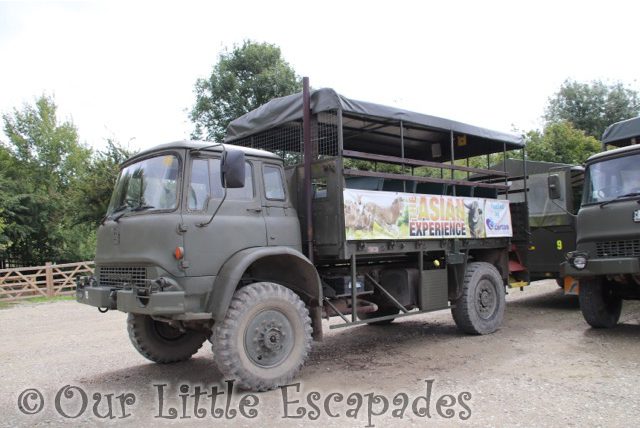
The safari takes you through a South American Experience, an Asian Experience, and an African Experience. The safari easily lasted an hour and our driver was full of information about the animals and the reserve.
At the South American Experience, you might be able to spot
- Spectacled Bears
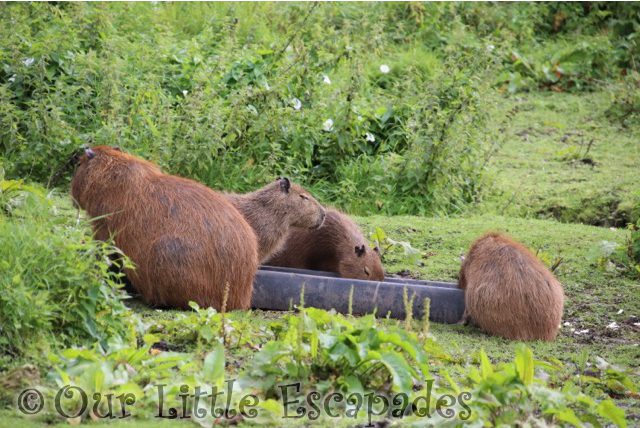
In the Asian Experience, you might be able to spot
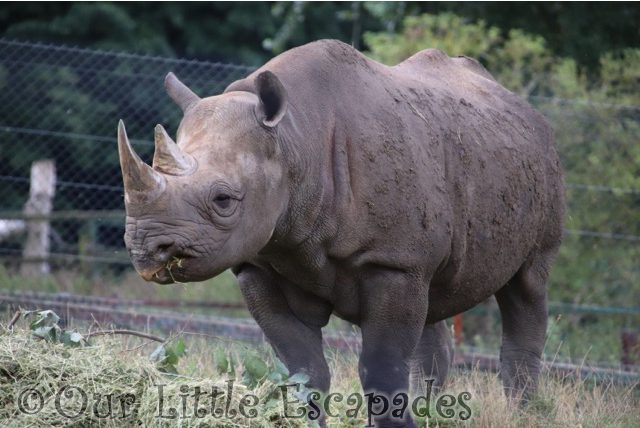
- Red River Hogs
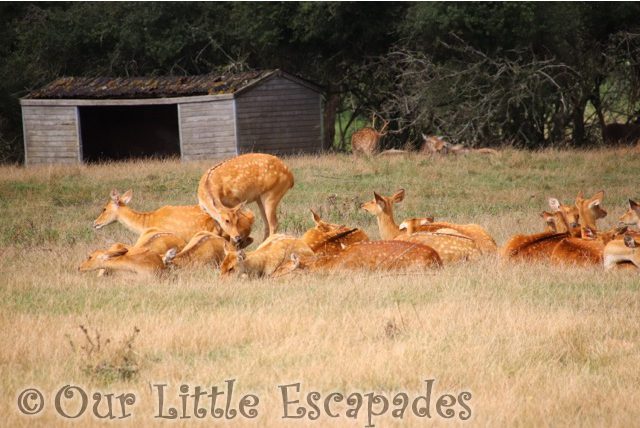
- Pere David’s deer

- Asian water buffalo

- Przewalski’s horses
In the African Experience, you might be able to spot
- Eastern black rhino

- African painted dogs
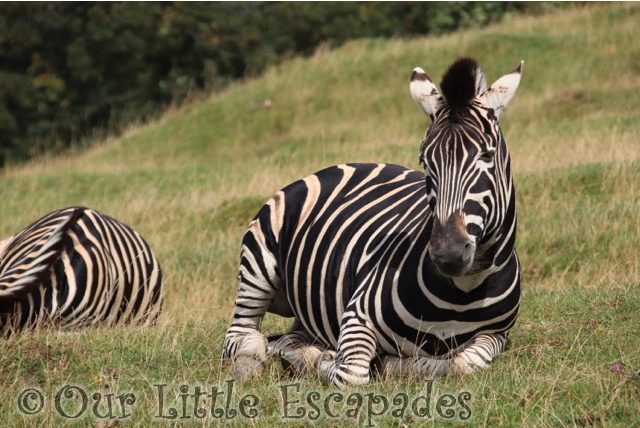
The safari truck drops you at the stop in Carnivore territory. This is located at the bottom of the reserve. The driver did give us the option to return to Basecamp with him but we wanted to explore this area next. From this point, you walk up the hill back towards Basecamp. There are parts that are steep. If you stay on a short break some of the accommodation comes with the use of golf buggies. I think these would come in very handy to visit the rest of the park.
We captured our safari experience in the below video.
Dinosaur Forest
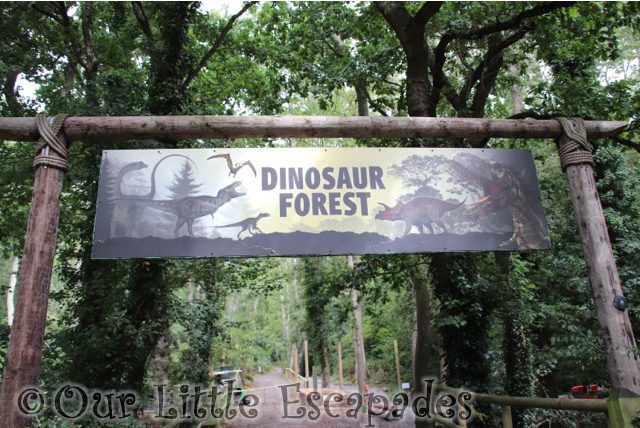
The next area of Port Lympne that we visited was the Dinosaur Forest. As expected this area is filled with dinosaurs. They are displayed in the correct timeline from when they roamed the earth.

The area contains lots of information about each dinosaur. We were even given a questionnaire about the dinosaurs to complete as we entered Port Lympne. We didn’t fill it in though as the children were having too much fun dinosaur spotting.
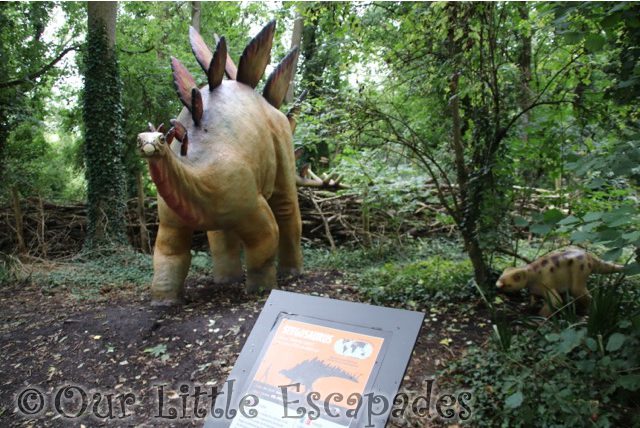
Dinosaur Forest is a lot bigger than we were expecting it to be and the children loved it.
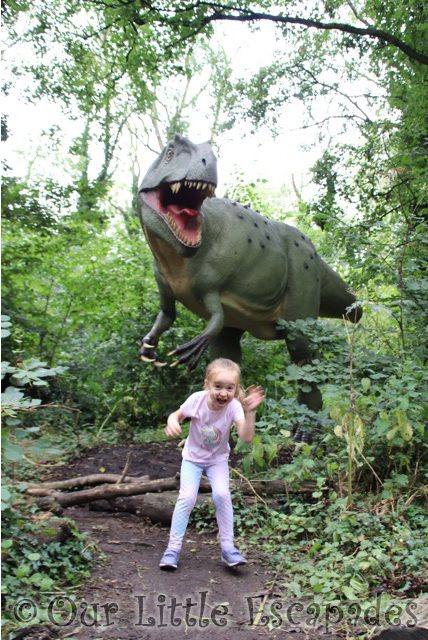
The below video shows us exploring the Dinosaur Forest.
Meeting A T-Rex
Every Sunday during the summer holidays the Dinosaur Forest has had another visitor. A ‘real-life’ T-Rex . We made sure we were there when it was time for him to visit.
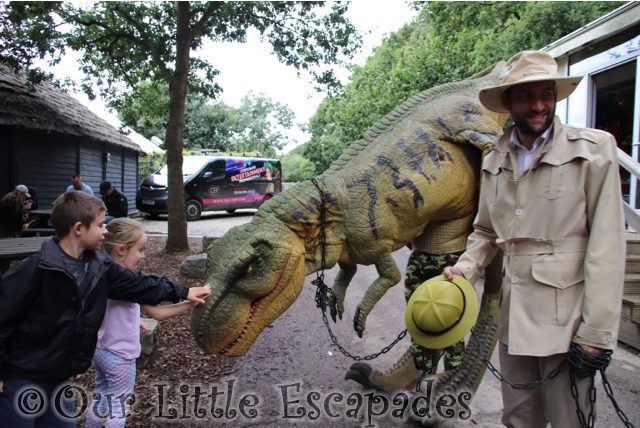
Joe the T-Rex was lots of fun and the children thought he was very funny.

Little E was even put in charge of him. She had to walk him around and keep him under control! You can see all the fun the children had below…
The Primate Trail
After we stopped for lunch at Babydoll’s Wood Fired Pizza we made our way around the pedestrian route. We headed towards the Primate Trail. The highlight of this part of the reserve for me was the Apes and Gorillas.
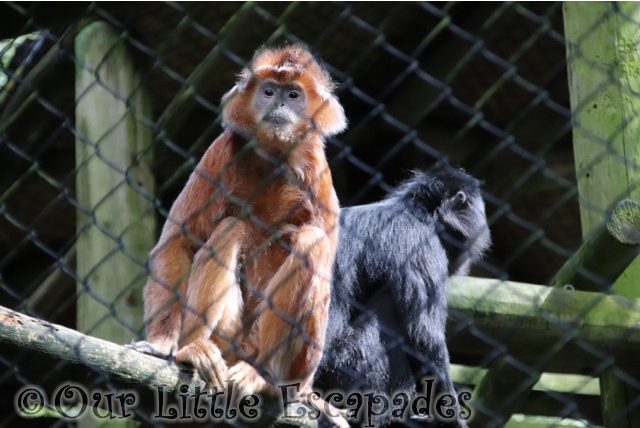
They are animals that Colchester Zoo doesn’t have, and I think they are a rare sight in many zoos.
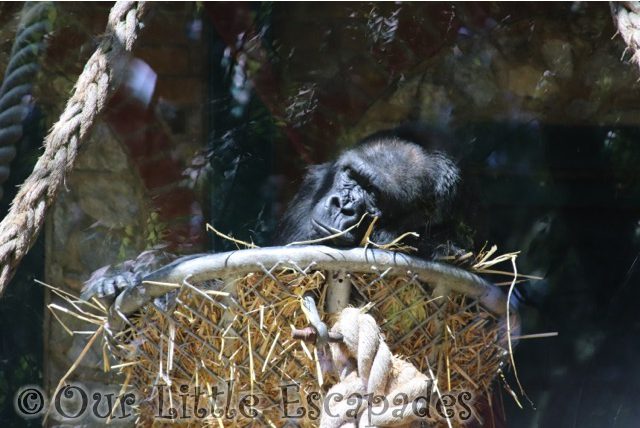
What was really amazing was that there was a baby ape. It was fantastic to see one so small. It is also nice to know that they are happy enough to breed at Port Lympne.
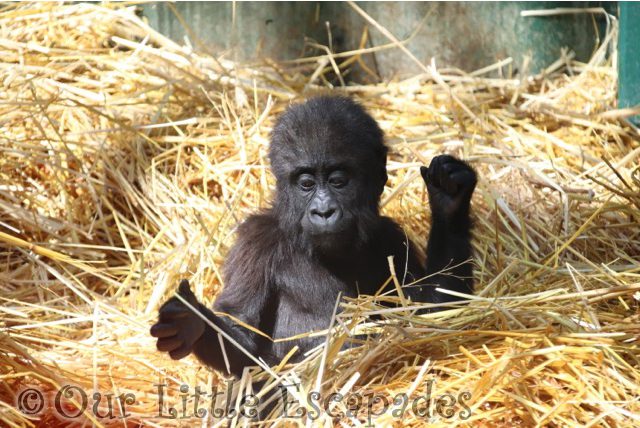
I really wanted to experience the Gorilla feed but Ethan had struggled during our visit so we decided to give it a miss on this visit. I’m hoping there will be a future visit where we can experience this.
The below video is the full vlog of our day at Port Lympne.
Our Thoughts Of Port Lympne
Port Lympne doesn’t have the feel of a zoo. There is a more relaxed feel in the atmosphere. There are so many different animals to see there.
The safari was a real highlight for us. Amazing to have this experience in the UK. It was also very educational for us all.
The children loved their time there and also enjoyed playing in the different playgrounds.
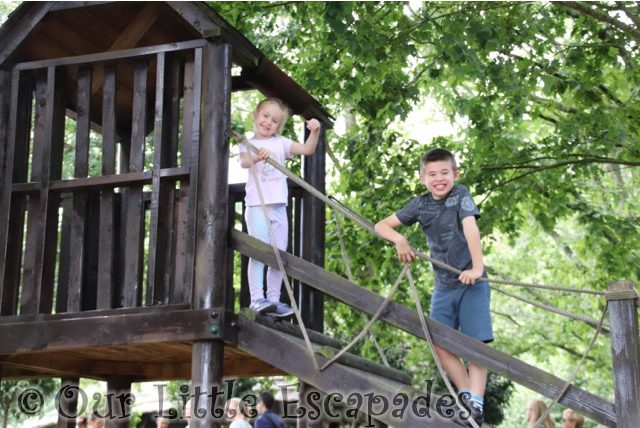
I feel like Port Lympne want to offer its visitors an experience to remember at their reserve. They do this by offering a very different short break experience. Even down to the restaurant where we ate lunch, it just feels so different from a normal zoo-type visit. Babydoll’s could easily be a standalone restaurant found in your local town.
We would love to return but we would like to experience an overnight stay . Preferably accommodation that includes a golf buggy. The hills of the reserve did call for the purchase of cake on our return to Basecamp.
DISCLOSURE – We were gifted entrance to Port Lympne Hotel & Reserve for the purposes of this post and to create our YouTube videos. We always give our honest opinions, findings, beliefs, and experiences.
Related Posts
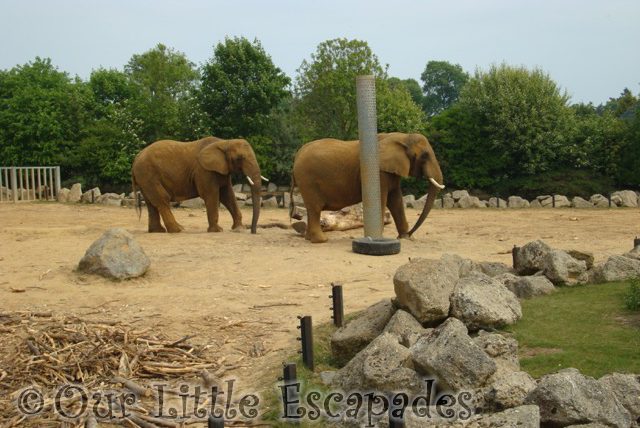
Ethan’s First Birthday Treat – Colchester Zoo
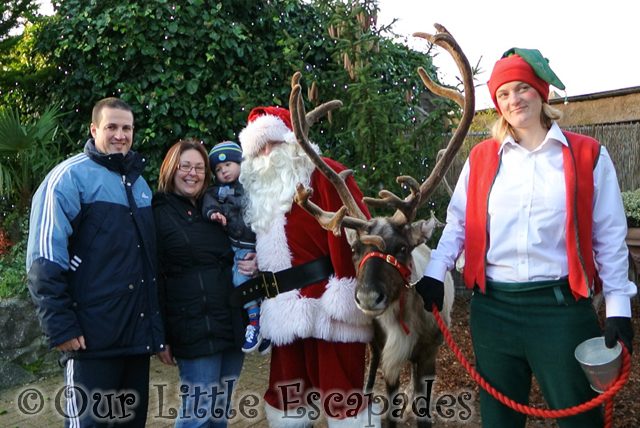
Breakfast With Santa at Colchester Zoo
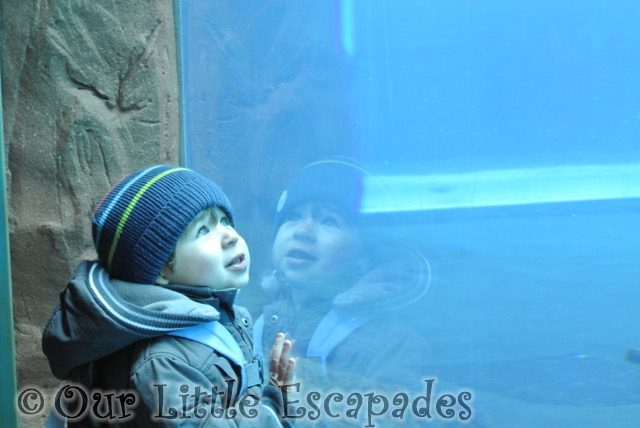
Breakfast With Santa – Visiting Colchester Zoo
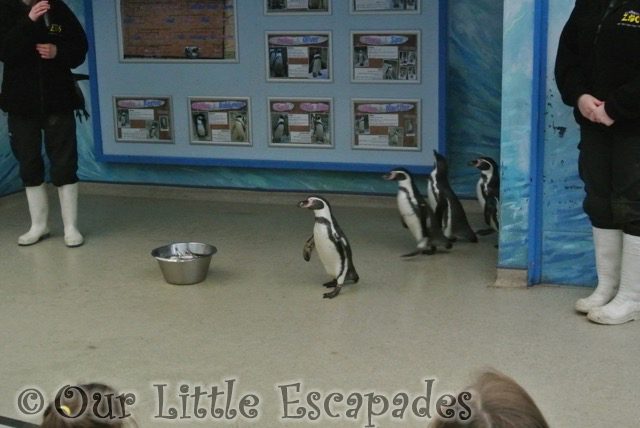
Our First Colchester Zoo Gold Pass
Leave a comment cancel reply.
Your email address will not be published. Required fields are marked *
Notify me of follow-up comments by email.
This site uses Akismet to reduce spam. Learn how your comment data is processed .

Review: An authentic African safari experience at Port Lympne Wild Animal Park
Did you know you can go on African safari just an hour from Tunbridge Wells? We went along to Port Lympne Wild Animal Reserve to check out the safari experience in the ‘Kent Serengeti’ as well as Dinosaur Forest and other awesome animals throughout the park.
After entering Port Lympne which is located on over 600 acres of Kent countryside, we were advised that the best way of seeing everything was going straight down to Base Camp and go on an African Safari bus which would last for just over an hour. We could then have lunch followed by taking a tour around the Dinosaur Forest and making our way back up to Base Camp, seeing more marvellous animals along the way.

Our first port of call was the Buggy Stop which is a covered area where we were able to leave the push chair for the rest of the day. Ben is getting fairly good at walking for longer periods anyway, but there are tons of Port Lympne push chairs scattered around the place for visitors to use should they need one.
The queue for the safari experience is conveniently next to a lovely playground which the kids had great fun in while we waited for our truck to arrive. A little tip for the safari – try to sit on the left side of the truck if you can , as many of the animals on the way down are on this side.

The Safari Experience is super! We got to see some amazing animals in their ‘natural’ habitats and the highlight of the day for me was seeing the baby giraffe which had only just been born. We started off by going through The Asian Experience followed by The African Experience where the animals roam free, which was another favourite too. There were zebras and antelopes literally wandering out in front of the safari truck and some gorgeous giraffes strolling around the field.

It was wonderful to see them in their own space enjoying life and roaming free. What also surprised me was how beautiful the views were across the landscape – we could see the sea from our truck and when we got to the highest part, we were able to look down at the amazing animals, across the rolling fields – it’s in such a stunning setting and is like nothing I have ever been to. Who would have known we have something so amazing close to Tunbridge Wells? Our driver was excellent with so much knowledge and interesting information about the animals too.

After going full circle, we got off the bus at Carnivore Territory and wandered up to the Cafe. We were pretty hungry by this stage as it was close to 2pm so decided to have lunch before visiting the Dinosaur Forest. There was plenty of seating outdoors and the weather was still fairly good so we had lunch alfresco. Lots of families had brought their own lunch but we got something from the cafe as a treat. If you are getting lunch there, it might be better to go slightly earlier as the choice was a little more limited when we arrived. However there were still a few options for hot food and a lovely looking cake selection with hot and cold drinks too.
Next up was the Dinosaur Forest which I have to say was terrific too! This section of the site opened in early 2016 and boasts the largest collection of life size dinosaurs in Europe. Visitors can wander around the trail and see all sorts of species with interesting facts about them along the way. The area is wild and natural and the children really enjoyed it. They have discovered a new-found love for dinosaurs again and have been talking about them ever since.

We made our way back up to Base Camp via the Primate Walk with the help of one of the Port Lympne buggies along the way for my youngest (thought the biggest was trying to get into it too). Seeing the Palace of the Apes is a must! We happened to arrive at feeding time for the monkeys and loved seeing them swing from branch to branch with their lunch in their hands. There was also a baby baboon following his parents around which was really sweet to watch.
After arriving back at Base Camp, we picked up our buggy and went to the Wolves & Tigers section which is located close to the entrance before visiting the git shop which had lots of reasonably priced animal-related toys as well as special gifts too. Harry chose a wind-up dinosaur to buy with ‘his’ money, a nice little reminder of fantastic and fun day out!
Find out more about Port Lympne HERE .

From playgroups, education and English Tutors to events, activities and fun for all the family, you are in the right place!
Find your next stay
Search low prices on hotels, homes and much more...

Get instant discounts

Get inspiration for your next trip More
New year’s eve in new york city.
Ring in the new year with iconic moments and unforgettable memories in New York City

Destinations we love
Stay in the know.
Error: Please enter a valid email address
Error: Sorry. An error has occurred.
Thanks! We've sent you an email so you can complete your subscription
List your property
- Mobile version
- Your account
- Make changes to your booking online
- Customer Service help
- Booking.com for Business
- Places of interest
- Guest Houses
- Unique places to stay
- All destinations
- All flight destinations
- All car hire locations
- All holiday destinations
- Discover monthly stays
- Unpacked: Travel articles
- Seasonal and holiday deals
- Traveller Review Awards
- Flight finder
- Restaurant reservations
- Booking.com for Travel Agents
- Coronavirus (COVID-19) FAQs
- About Booking.com
- Partner help
- Sustainability
- Press centre
- Safety resource centre
- Investor relations
- Terms & Conditions
- Partner dispute
- How we work
- Privacy & Cookie Statement
- Cookie Settings Manage cookie settings
- MSA Statement
- Corporate contact
- Content guidelines and reporting
Booking.com is part of Booking Holdings Inc., the world leader in online travel and related services.
Verified reviews from real guests.
We have more than 70 million property reviews, and they're all from real, verified guests .
How does it work?
It starts with a booking.
The only way to leave a review is to first make a booking. That's how we know our reviews come from real guests who have stayed at the property.
Followed by a trip
When guests stay at the property they check out how quiet the room is, how friendly the staff are and more.
And finally, a review
After their trip, guests tell us about their stay. We check for naughty words and verify the authenticity of all guest reviews before adding them to our site.
If you booked through us and want to leave a review, please sign in first.
Check-in date
Check-out date
- Blog Archives
- Copyright | Cookie policy
- Literature
- (V)IPs Zoos
- Rest of the World
- Endangered Species
- Species Classification
- (V)IPs Evolution
- Latest Newsletter
- Newsletter Archive
- Subscription
- Video Gallery
Select a Zoo
Reviews — zoos in europe, history description, history documentary.
During the second half of the nineteenth century the first menageries in Moscow were established as entertainment facilities. The first was founded in 1855 by two Frenchmen (names unknown), while the Kreuzberg family owned a private menagerie that opened its door to the public in 1862 . Together these animal collections formed the heart of the Moscow Zoological Garden founded by the Society for Acclimatization of Plants and Animals, which was established by professors of the Moscow State University. The initial idea for such a zoological garden came in 1857 , but it took the Society, including one of its founding fathers professor Anatoly P. Bogdanov, until 1863 to be able to buy property for the future zoo. The Zoo was opened to visitors on 13 February 1864 at the location where it still exists until this very day. On opening day 287 animals were on display, of which 134 were domestic animals, while the others were exotic specimens such as tigers, lions, jaguar, leopard and rhino.
In those days it was an unique experiment to create “a living museum outdoors,” as professor Bogdanov said, in such severe climatic conditions of central Russia. The primary purpose of the Zoological Garden according to the members of the Society was:
to collect alive specimens of higher vertebrates ( firstly — the animals of Russian fauna) for scientific observations;
to establish a collection of typical animals that could serve educational purposes, i.e. distribution of zoological knowledge among the wide public communities;
to carry out scientific experiments and observations of important animals, especially domestic animals of Russian breeds.
The Zoo was financed by the entrance fees and private donations, including contributions by members of the imperial family. In the first years the annual number of visitors grew up to ten thousands. Nevertheless, the incomes did not cover the expenses and the Moscow City Council refused to give financial support. So, the Zoo went into private hands of the Ryabinins’ family in 1874 . They transformed the Zoo into an amusement park and in three years time ruined the place. In 1878 the Zoo was run by the Society for Acclimatization of Plants and Animals again, including fund raising activities. This time the Society was able to manage the Zoo successfully, and even to buy a number of animals. But in the turmoil of the Revolution of 1905 the Zoo was severely damaged: the buildings were ruined, the library was set on fire, many animals perished. So, for the second time the Society was forced to turn over the Zoo to private owners.
Then in 1914 World War I broke out. For the Zoo this meant that in the autumn of 1914 the only building that remain to this day was transformed from the director’s premises to a hospital for wounded WWI soldiers. The WWI impact compounded Russia’s suffering from a number of economic and social problems, which resulted first in the 1917 February revolution followed by the October revolution. In the aftermath of the Great October Socialist Revolution of 1917 and the fall of the Russian Empire, the Society ceased to exist, and in 1919 the Zoological Garden was declared national property and transferred under the responsibility of the ministry of Culture of the communist Moscow parliament, the Mossovet. In 1922 it was transferred to the authority of Moscow City Council and since then it has been supported by the City Authorities. Construction work began on the Zoo grounds. The Zoological Garden premises almost doubled in size with the establishment of the ‘New’ territory on the opposite side of Bolshaya Gruzinskaya street. New exhibits, which followed the principle of Carl Hagenbeck’s bar-less enclosure design were established. One of the most interesting exhibits of the Zoo called ‘Animal Island’ still exists. It was a high stony rock surrounded by a deep water ditch that separated the visitors from bears, tigers, lions and other large predators on the ‘Island’. The total size at the time was nearly 18 hectares.
In 1926 the Zoological Garden was renamed ‘Zoological Park’. At that time the range of activities extended, the animal collection increased considerably with expeditions collecting wildlife in Central Asia, the Far East and the Caucasus. New departments were established, focussed on for instance scientific research, education, veterinary science and nutrition. In those same years Moscow Zoo was the first zoo in the world where educational activities were the main priority.
In 1924 the Zoo had established the Young Biologists Club that gathered like-minded young people that joined in real scientific research. Many of them became a Zoo employee. The Club was founded by Petr Manteifel, who also was the pioneer father of the science called ‘zoo biology’. Manteifel and his young biologists discovered a way of artificial breeding sables (Martes zibellina), which were on the verge of extinction due to man’s insatiable pursuit for its expensive fur. In the 1930 s during Stalin’s great purge many members of the Young Biologists Club were arrested accused of spreading anti-soviet propaganda and liberal-minded ideas and having contact with German colleagues at Berlin zoo, some were even executed as foreign spies. The Club was considered a non-governmental organisation beyond the direct control of the authorities, which in fact was partly true because the Club was a real democracy, with membership available to all.
Although many animals were evacuated and many of the zoo staff were called to arms at the beginning of World War II the Zoo was kept open. Of the 750 employees at autumn 1941 only 220 remained on the staff, most of them women. Getting enough food for the animals was a constant challenge, for instance carcasses of killed horse at the battlefield around Moscow were brought to the zoo. More than six million people visited the Zoo from 1941 to 1945 to enjoy the sights of animals that had remained.
At wartime the scientific work proceeded, perhaps even more intense than before or after the war. The scientific staff worked especially on development of antibiotics. But the most important mission of the Zoo during the war was to give people hope. It produced the illusion of a peaceful life until people survived through the desperation of the war with the Red Army soldiers as the most frequent visitors of the Zoo. Which were given the pleasure of watching newborn offspring even during the war.
During the soviet union period ( 1922 − 1991 ) not many highly ranked people cared about the zoo — no soviet leader had any interest in it. The city encroached on the zoo premises, while the zoo needed additional space for the ever expanding zoo population of animals. Because the breeding results were still excellent.
The Zoo lived up to the goal it had set for itself and made educational activities the main priority. Zoo staff distributed knowledge in the field of natural history and tried to raise the public awareness and concern about the necessity for wildlife conservation. The zoo assisted schoolchildren and students with studying biology, actively participated in scientific research, and actively contributed to scientific publications. So, the Zoo became one of the larger scientific institutions in Moscow. And of course it still was the favourite recreational place for Moscow citizens and those who visited the city.
As off 1974 when Igos Sosnovsky retired as director and his successor Vladimir Spitsyn took over Moscow Zoo became part of the international zoo community again. Sosnovsky as a WWII veteran hadn’t been able to brush aside the fear of repression and avoided all international contacts for some reason. Spitsyn restored all international activities from before the war and the Zoo became member of many European and International Breeding Programmes in which it exchanged its rare and endangered animals, shared experience and information.
Although already in the 1970 s improvement of all zoo facilities was needed and ideas of a new zoo in another region of Moscow were launched, nothing happened due to local economical and social problems. By the end of the 1980 s the Zoo’s condition became alarming. Facilities were deteriorating, enclosures were dilapidated and technical equipment needed to be replaced as well. And while a few improvements had been achieved — such as a partial renovation of the main entrance, the monkey house and lion house — urgent measures were still needed.
Then, in 1992 the new Moscow government made a decision to start the most ambitious reconstruction project in Moscow Zoo’s history with the first stage of the project to be completed by 1997 , when the 850 th anniversary of the City would be celebrated. Anatoly A. Andreev who had been involved in the Zoo’s design and architecture since the 1970 s headed the team of architects. The project’s renovation objectives were focussed at (a) preservation or partial renovation of the historically valuable buildings and existing pools, (b) reduction of the noise from the surrounding streets, © connection of the Old and the New territory via a footbridge, and (d) expansion of the Old territory by incorporating adjacent areas and buildings.
Besides the preservation and renovation of almost all important zoo constructions, including the ones that actually were dilapidated, many new enclosures and facilities were built. Already in 1993 the footbridge that connected the Old and New territory was completed. It allowed visitors to avoid crossing the busy B. Gruzinskaya street with its heavy traffic. In 1993 other constructions were completed as well, such as an enclosure for large birds of prey and a complex of enclosures for feline species, including leopards, Pallas’ cats and lynx. Next, the Hagenbeck-style ‘Animal Island’, one of the most remarkable exhibits in the New territory, was renovated. The historic appearance with enclosures that resembled the natural habitats of Amur tiger, striped hyena, African wild dog and Asian black bear was preserved. Later they introduced Asian lions in one of the enclosures around the large rock in the centre of the ‘island’. During the renovation they created the Exotarium, which held several aquariums, inside the rock on the second floor.
The following years many more enclosures were renovated, besides the new research and veterinarian facilities that were put into operation in 1994 . In 1996 , the main entrance itself (featuring a small artificial waterfall) was reconstructed. The same year the old, dilapidated elephant complex was demolished and a new elephant house was erected at the same spot, while the inhabitants (four African elephants and four Asian elephants) were temporarily moved to a a former tram depot that was completely renovated and specially equipped. A new children’s zoo was opened in the New territory, including a children’s theatre that organises shows with educational elements. And besides several aviaries, a pavilion for water birds was built on the shore of the large pond in the New territory.
Although in those days 4 additional hectares of space was added to the former existing 18 hectares, the Zoo still lacked space to create favourable conditions for their species to breed. And its location in the centre of Moscow didn’t contribute to the favourable breeding conditions they wanted of course. Therefore, the 200 hectares area near the city of Volokolamsk (about 100 km from Moscow) that was given to the Zoo in 1996 for the establishment of a breeding station was very much welcomed (see also Breeding Centre ).
The first major stage of the general reconstruction of the Moscow zoo represents a unique event. Not only over 50 facilities have been renovated ( 90 % of all existing facilities) and newly built, but it was achieved in such a short period of time. But maintenance and small and larger refurbishment is ongoing business in a zoo. So, i n 2002 , the Moscow City Government and the City Council allocated the necessary funds to start construction of a new pavilion for the Asian elephants. In 2003 the three elephants could move house already, and in spring 2009 , the first newborn elephant calf was welcomed.
The Moscow Zoological Park has come a long way from the small zoological garden it was to the large institution of scientific research, education, conservation and recreation it is today. And due to the dynamics of the standards used in the zoo community regarding animal health and welfare, Moscow Zoo is constantly improving its facilities, also during 2014 celebrating its 150 th anniversary.
(Source: Moscow Zoo website; Zoo with a Human Face, to the 150 th anniversary of the Moscow Zoo — a documentary by Darya Violina and Sergei Pavlovsky, 2014 ; Zoo and Aquarium History by Vernon N. Kisling, Jr., 2001 ; Wikipedia)
An account of 150 years of history of the Moscow Zoo
(A documentary by Darya Violina and Sergei Pavlovsky)
The history of Moscow Zoo shown through the perspective of the lives of the people who have been important to the Zoo’s development and continuous progress over those many years since 1864 . Thousands of photographs, hundreds of chronicles, accounts and recollections that have preserved the story that began so long ago, against all odds, and lasts uninterrupted to this day. A documentary about those who have devoted their lives to serving a noble and rewarding cause, those who have started from scratch, those who maintained that work and about those who revive the Zoo as off today.
(Source: sdpavlovskiy YouTube channel)
20 . 06 . 2014
Finally, Moscow Zoo is paid a visit. I have been looking forward to this for quite some time. It has been on my to-do list since I learnt about the large collection of feline species on display at the Zoo. So, I am here on this sunny day in June to satisfy my curiosity, in the year they celebrate the Zoo’s 150 th anniversary.
I am entering as one of the 1 , 5 million paying attendance yearly. Which is not even half of the total number of visitors a year. This is about 4 million, because there are specific categories (e.g. disabled, pensioners, children, students, etc.) for whom the admission is free.
OLD TERRITORY
I turn left after the main entrance to visit the large predator section of the Old territory. Not that only here you will find predators, but the greatest part of their predator collection is grouped in this section. I will come back to the grouping of Moscow Zoo’s animal collection later. After having walked along a fence that blocks most of the views on the work in progress at the lake I arrive at what they call here the ‘tropical cats’ section: Bengal tiger (unfortunately the genetically aberrant version — a white tiger), jaguar and cheetah. Both the tiger and the jaguar have their indoor enclosures in the same house built at the perimeter of the premises. The cheetahs have their shelter for the night and bad weather in their outdoor paddock, so that cannot be visited. The tiger and the jaguar however have interesting housing that serves the needs for both the cats and the visitors. The latter are pleased with Asian and South American (Inca) ornaments to make sure they understand the geographical origin of the species. While the walls have murals representing the species’ original habitat … Machu Pichu for the jaguar. The animals themselves have various enrichment features at their disposal, including high level observation posts, in rather small exhibits. The outdoor facilities for these two species are accessible from the indoors. It has natural vegetation, but not a lot. Likewise there are not a lot of options to shelter from extreme weather or loud crowds. Although the cats have access to several resting posts at different levels, these enclosures can do with some improvements — at least more vegetation — to make them better fit for purpose, in my opinion. The enormous exposure of the cats is also due to the fact that they use windows to separate animal from man along almost the total length of the enclosures.
When I walk the few steps to the entrance of the Bear House, which is like the jaguar and tiger indoor enclosure built at the edge of the Zoo grounds, I pass in between the Pallas’ cat exhibit and a second jaguar exhibit. The Pallas’ cat has a flat grassy area with three large trees, some shrubs and a potential pond (when filled with water) available in its outdoor enclosure. Windows all around and a wire mesh roof prevent the cat from fleeing this scenery that doesn’t resemble the cat’s original Himalyan habitat. Across the footpath there’s a jaguar enclosure that’s more interesting than the one directly neighbouring the tiger. This one has a small stream and loads of vegetation and a multilevel resting platform. Still the animal is quite exposed.
The Bear House provides a nice and secluded area where three adjacent bear enclosures houses sloth bear and spectacled bear. As a visitor you walk via a roofed corridor more or less in the dark along the enclosures having good views on the exhibit via man-sized windows. The enclosures have a dry shallow moat at the visitor’s side, but I don’t think this withhold the bears from coming close to the windows. The enclosures are small but almost completely filled with enrichment features including various platforms, a tree trunk structure, rubber hammocks and natural vegetation. Considering the design I think these enclosures offer peace and quiet for the bears, unless people start banging the windows of course.
In slightly larger enclosures they keep Amur leopard, snow leopard and cougar ( Puma concolor ). At all of these felid species enclosures the distance between the public barrier and the fence does allow contact when people lean far forward.
Further along the footpath around the corner the arctic fox and the dhole are housed in enclosures that have a similar interior design as those for the felids. Despite the fact that these species live under different natural circumstances in the wild (forest and tundra habitat respectively).
When I walk back to have a look at the large birds of prey aviary I cannot prevent myself to have a brief look at the giraffe enclosure as well. It’s obviously a relic of the past that is not fit for purpose anymore. Still they have one reticulated giraffe on display at a saddening small area. It loves to be fed by the public that doesn’t care about the warning not to feed the animals. On the other side of the building a similar pitiful situation for the single white-tailed gnu can be seen.
One of the most extraordinary group of species brought together on display can be found right after the row of predator enclosures. The maned wolf from South America has the red-necked wallaby and emu from Australia as neighbour. But also in the same area the African wild dog is on display as well as white-tailed gnu (Africa) and kiang (Asia) in the row of stables along the rim of the premises.
The raccoon exhibit is worth mentioning considering the aforementioned accident risks. It has a very typical enclosure design with electrical wire on top of windows surrounding the entire exhibit. The electrical wire is within reach of the public. So, there are numerous warning signs! But why they installed electrical wire on top of windows that are unclimbable for raccoons? To keep out the public perhaps?
In the bird house, in the far end corner from the main entrance, birds from all geographical regions are grouped together, including Humboldt penguin and African penguin. The house consists of two part with one part half empty, and has also very common species on display, such as wild turkey, common pheasant and European hedgehog. Outside this building several aviaries comprise a large array of parrot species (South America and Australia).
Proceeding with my tour around the Old territory I have a look at the Asian elephant house and its surrounding grounds. The fancy steel with blue details of the elephant house doesn’t appeal to me, but that is just a matter of taste. It is definitely the most modern exhibit in the Zoo I’ve seen yet, in style and in size, with a nice pool at the visitor’s side.
I skip the reptile house to save some time, and money too, because an additional fee complies. So I walk straight to another modern enclosure — the bar-less and moated wolf exhibit. Although it has a Hagenbeck-style design, the space available for the wolves is ridiculously small. The wolves will never be able to cross the water-filled moat and climb the wall and thus break out, still there is impressive electrical wiring in place on top of the wall. Again, probably to keep out the public.
Making my way to the footbridge that connects the Old and New territory I pass along a very old-fashioned row of enclosures built in a semicircle in front of the 16 metres high sculpture by Zurab Tsereteli called ‘Tree of Fairy Tales’, 1996 . The enclosures house several species of mustelidae (sable, European polecat, stone marten), as well as African wild cats. Then followed by several aviaries again. At this point I am really lost regarding the way they group the Zoo’s animal collection.
NEW TERRITORY
Proceeding clockwise I find the doors of the Tropical House closed for renovation. So, no butterflies for me this time. But in one of the two spacious aviaries around this house I discover several ducks, such as the mandarin duck and the black-bellied whistling duck, together with the common kestrel ( Falco tinnunculus ), though neither rare nor endangered.
Then a rather special exhibit appears, the Animal Island, which was developed in the 1920 s as one of the first Hagenbeck-style enclosures in the New territory. Although it took some renovation activities it still exists to this very day. In the centre of this moated area they have erected a fake ruined fortress, which serves as the background for the species in the surrounding exhibits. These bar-less exhibits have a more modern appearance but it isn’t necessarily an improvement for the animals. For instance the Asian black bear has a bare environment with minor enrichment available and no vegetation, but the brown bear is even worse off in a similar enclosure but next to nothing of enrichment features. The tundra wolf ( Canis lupus alba ) and the striped hyena have a little better place at their disposal, but the Asian lions have by far the best enclosure. They have several resting platforms, trees and a stream that ends in the moat. Again to save time I skip an exhibit. This time the Exotarium with its aquariums that has been created inside the ruined fortress and by the way requires an additional fee to get in.
One of the rare areas in Moscow Zoo where you find mixed-species exhibits is called ‘Fauna of the Savannah’. It has a South American section with capybara vicuna and guanaco, and — very importantly — a large pool at the disposal of the largest rodent on earth. Though absolutely not endangered, these water-loving capybaras should have access to water at all times, in my opinion. The real savannah area with African species has several enclosures. A mixed species exhibit with sable antelope and dikdik. And Grevy’s zebra together with ostrich and giraffe. Also this time there’s only one giraffe in the paddock. The location of the meerkat enclosure is well chosen, because when they sit on top of one of their hills they can watch the other animals. Although it is the largest and probably the most modern facility at the Moscow Zoo I still think it is disappointingly mediocre compared to other zoos I have seen in Europe and North America.
Before I go to the primate section I buy myself an ice cream and walk along the horse stables on the eastern edge of the New territory premises. Looking for an answer to the question “why are there horse stables at this place?” The question still waits for an answer.
At Moscow Zoo they keep both Sumatran as Bornean orangutans, which is quite unusual. The outdoors for the five individuals, including 2 young, of the Sumatran species looks impressive due to the enormously high rock face at the rear. The wall looks extra impressive because it is rather close to the viewing windows. Unfortunately, the exhibit lacks trees and vegetation other than grass while the enrichment is scant and I don’t see puzzle feeders. The Bornean orangutans have a similar outdoor enclosure, but it is suggested that olive baboons ( Papio anubis ) are on display here as well. It could be that they alternate in the same outdoor enclosure, but this is not very clear.
The western lowland gorillas also have a similar outdoor enclosure design due to which the animals are enormously exposed to the inquisitive public. Considering the number of youngsters Moscow Zoo appears to be having good results breeding orangutans and gorillas.
Indoors, all the great ape exhibits have much enrichment and jungle-like murals, but the agile gibbon has even more enrichment inside. I haven’t seen a specific outdoor enclosure for the agile gibbon but it could be possible that it alternates with the Sumatran orangutans. Only this enclosure lacks high trees or other options for the gibbon to brachiate, which is its natural behaviour in the canopy of the gibbon’s native habitat, the rainforests of southeast Asia.
The terrarium building, located behind the Primate House, is beautifully decorated with little mosaic tiles. They have the usual row of exhibits, but in this case especially the larger reptiles and tortoises (python, crocodiles, alligator, tortoise) are kept. And outside they have two giant tortoise species, the Aldabra and the Galapagos tortoise.
On my return to the exit I pass the exhibits of a few of the many predator species they have on display at Moscow Zoo. The polar bear is provided with a big heap of artificial ice, but that’s about it when it comes to enrichment, though there are some plastic drums to play with. The enclosure as such is the prototype of polar bear enclosures worldwide, rear wall of cement and large bricks, concrete floor, large and deep water-filled moat. Unfortunately, again here the annoying reflecting windows. The yellow-throated marten I do not see, and the same counts for the Eurasian otter in its large elongated outdoor exhibit with a shallow pool along the whole length. It must be great to see the submerged otters swim in this pool.
Conclusion There are several ways to group a collection of animals which can support a zoo’s educational efforts. Of course, some people just come to the zoo to be entertained, but when an individual is ready to learn some things the worst thing you can do is confuse him or her. And to be fairly honest, confusing it is. Sometimes they group the collection according their taxonomic tree, which is the case with the felids, the bird species and the primates. Then again they have decided to present the collection by geographical origin, like in the ‘Fauna of the Savannah’, or according original habitat like the mountain-dwelling tur and markhor. And at some point they just make a mess of the grouping, for instance in the area with the maned wolf, the red-necked wallaby and others. In the end it seems the Zoo just want to have on display as many species as possible, because all species that live in herds they keep them in small numbers. I do understand that it is not easy, requires tough decisions and certainly is not cheap to rearrange your entire collection, especially when it is that huge as it is here at Moscow Zoo. Anyway, further renovation is foreseen and probably some rethinking as well.
I hope that they get rid of all these windows they have at so many exhibits. For some situations it is inevitable I understand, but I sincerely hope they will return to the original Hagenbeck idea of bar-less enclosures, taking into account modern husbandry standards of course. As the position of the sun makes it sometimes hard to get even the slightest glimpse of the animals due to the reflections in the windows. And last but not least they have the tendency to have windows all around or at more than 50 percent of the perimeter of an enclosure. Most of the time leading to more exposure of the animals to the public and possible unrest.
Sumatran orangutan youngsters at Moscow Zoo
Just another day at the zoo for these orangutans ( Pongo abelii ) — nothing much exciting going on in this safe and secure environment. But wouldn’t it be nice to see them swinging and romping in the forests of Sumatra.….
Raccoons at Moscow Zoo
Raccoons are known for their habit to clean their food in the water before eating it. It seems they also want to have a clean ball before playing with it.
Breeding Centre
Information and education, zoo details, breeding farm.
The Moscow Zoo has always been trying to create the most favourable conditions for their animals to fulfil their basic needs. Not only for animal health and welfare purposes but also to breed the animals successfully. These specific breeding conditions could not be achieved due to its location in the City centre and the lack of space. In 1996 the Zoo came into possession of an area of 200 hectares near the city of Volokolamsk (about 100 km from Moscow). In this picturesque hilly area of the former quarries of the Sychovo mining factory, with streams, springs and artificial ponds better opportunities were available for breeding various — predominantly rare — species of animals.
The main goals of the Breeding Centre, besides maintaining rare and endangered species of animals, are establishing breeding pairs and groups and developing new husbandry methods. Since excessive disturbance is likely to have adverse effect on the breeding efforts, the actual Breeding Centre is not open to the public.
The construction of the Breeding Centre started in March 1996 . The first inhabitants of the Centre were birds of prey and waterfowl and they have been successfully breeding birds ever since. The collection of waterfowl has grown notably since the beginning. Apart from the numerous mallards and ruddy shelducks, the inhabitants of the ponds include pintails, pochards, tufted ducks and black geese of the genus Branta. Bewick’s swans are thriving, raising their chicks every year. Japanese, white-naped and Siberian cranes are also breeding successfully and many other species, including parrots. The breeding centre for birds of prey is continuously expanding, with Himalayan griffon vultures, golden eagles, imperial eagles, Steller’s sea eagles, and black vultures among its most prominent inhabitants. Regular breeding has also been achieved in saker falcons ( Falco cherrug ).
They keep carnivorous mammals as well at the Breeding Centre. These include endangered species such as Amur leopard, Pallas’ cat, cheetah, Amur tiger, dhole, wolverine, and yellow-throated marten. Of these species the Amur leopard is listed Critically Endangered according the IUCN Red List of Threatened Species™ , with about 45 individuals left in the wild. The Zoo’s track record says they have produced offspring from Pallas’ cat, dhole, yellow-throated marten, and Amur tiger.
For the ungulates that are kept at the Centre the environment is almost ideal. There are bactrian camels as well as kiangs, Saiga antelopes, blue sheep and vicunas. Hoofed animals originating from mountainous areas have large paddocks at their disposal that are situated on the slopes of the surrounding hills, more or less similar to their natural habitat.
Besides the more rare and endangered species the Centre also has an interesting collection of domestic hens, a horse stable and a dog-breeding centre, mainly for the breeding of Central Asian sheep dogs. Furthermore, there is a small quail farm and a poultry farm with layer hens.
Moreover a subsidiary farm in Lotoshino houses some cattle, smaller livestock, and the main herd of bactrian camels and yaks. The area of the subsidiary farm is about 51 hectares and it comprises hayfields, pastures, a sheepfold and an apiary. Most importantly it provides the Moscow Zoo with ecological feed for its animals.
The Breeding Centre’s collection comprises 10 species of carnivores, 6 species of ungulates, 74 species of birds and a great number of domestic animals, but the collection is expanding constantly. Although it is still closed to visitors, the Zoo’s goal is to open part of the farm (as they call the Breeding Centre themselves) to outside visitors soon. They plan to create an additional safari park at the location of the Breeding Centre.
(Source: Moscow Zoo website; Zoo with a Human Face, to the 150 th anniversary of the Moscow Zoo — a documentary by Darya Violina and Sergei Pavlovsky, 2014 )
Information panels and Education at the Zoo
First thing to be noticed of course is that the information on the panels around Moscow Zoo is given in the Russian language. And no other language. This is not unexpected as most of the information provided in Moscow is only in Russian. Fortunately, the name of the species on display is given in English as well, together with its scientific name. As far as I can tell and understand no information is provided on the species conservation status (or IUCN Red List status). On the new revamped website this information is available but only in Russian and no icons or logos are used, so you have to rely on machine translation services. The panels show geographic maps of the species distribution and sometimes the IUCN status and if the species is part of EEP /ESB, as well. But this is not done consistently, and I am not sure how reliable the information is. Nevertheless I have been able to find on the internet a list of species that represent the Moscow Zoo contribution to the European Endangered species Programmes (EEPs).
There is also a zoo school that is primarily focussed on children, and I assume that the Young Biologists Club still exist. Foremost because it has been very successfully delivering a range of important staff members over the years.
- Directions
directions to Moscow Zoo
Address : B. Gruzinskaya 1 123242 Moscow Russia
public transport
The metro system can be quite intimidating for foreigners because of the language issue, but I can assure you it is the best way of navigating the city. The metro stations are the most beautiful I’ve ever seen and buying tickets can be done using sign language (see the tripadvisor website how it is done). When you are not able to decipher the Cyrillic alphabet on the fly it is best to prepare your metro trip beforehand and make sure that you know how many stops you have to travel from the departure station to your destination, including transfer stations. Another way of travel support is the Art-Lebedev metro map , which has the names of the stations both in Russian and English mentioned. The most fancy way however is by using the Russian metro app on your smartphone. The Yandex.Metro app — provides a bilingual metro map which can even build connection routes for you and estimate travel times.
Moscow Zoo’s main entrance is conveniently located right across from the Krasnopresnenskaya metro station on the Brown Circular line (no. 5 ). Also the Barrikadnaya metro station is rather close to the main entrance, Purple line (no. 7 ).
by bicycle
As mentioned already Moscow is a very large city. So, it really depends on how close you already are to the Zoo if cycling could be an option. The obvious challenge is the traffic which has grown dramatically in recent years — the centre of Moscow is a non-stop traffic jam. Furthermore the poor driving habits of Moscow motorists are notorious, from road rage to rear-ending. In addition, knee-deep snow and the grimy slush that inevitably follows during the long and fearsome winters doesn’t make cycling in Moscow a very attractive mode of transport. Nevertheless the City Council tries to make the city more bike-friendly with a bike rental scheme like in many major cities around the world. I decided to use the metro.
There is no dedicated parking available at the Zoo, but if you really want to drive yourself you can get directions below by providing your point of departure.
From : -- Choose source -- Moscow Zoo or
Download the zoo map here .
Goal: 7000 tigers in the wild
“ Tiger map” ( CC BY 2 . 5 ) by Sanderson et al., 2006 .
Latest Additions
Tallinn zoological gardens, tallinna loomaaed, stadt haag zoo, tierpark stadt haag, salzburg zoo, krefeld zoo, cerza zoo, cerza parc zoologique lisieux, bratislava zoo, rheine zoo, naturzoo rheine.
- #Luxury travel
- #Unusual Moscow
- #Jewish Heritage
- #Russian traditions
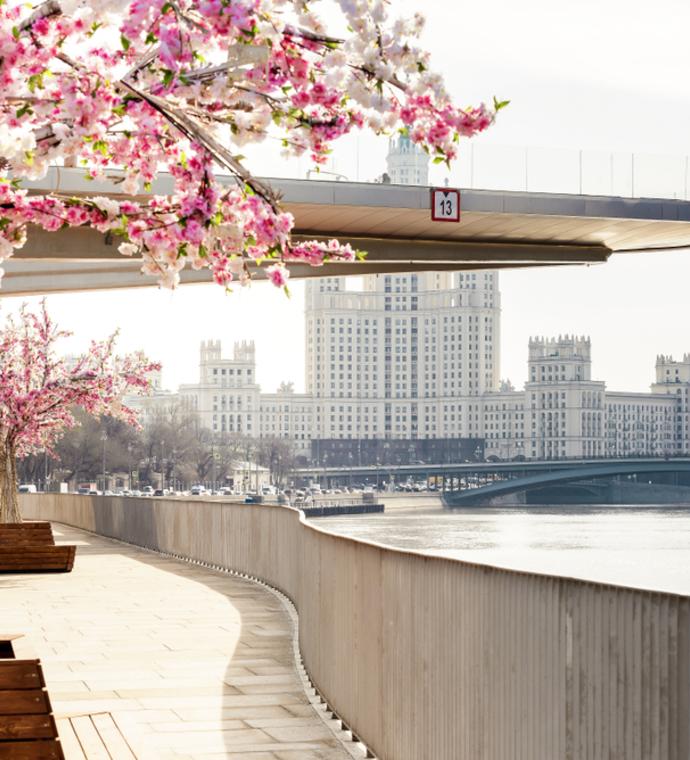
Zaryadye Park: new symbol of Moscow
- #Interesting places
Zaryadye Park is a new symbol of Moscow.
Being located in the very heart of Moscow, next to the Kremlin walls, Zaryadye Park is not just an ordinary park. It is a cultural and educational center with a unique botanical collection of plants taken from some nature zones of Russia (forest, steppe, meadow and northern landscape), that comprises more than 1 million green plants, including rare species listed in the Red book.
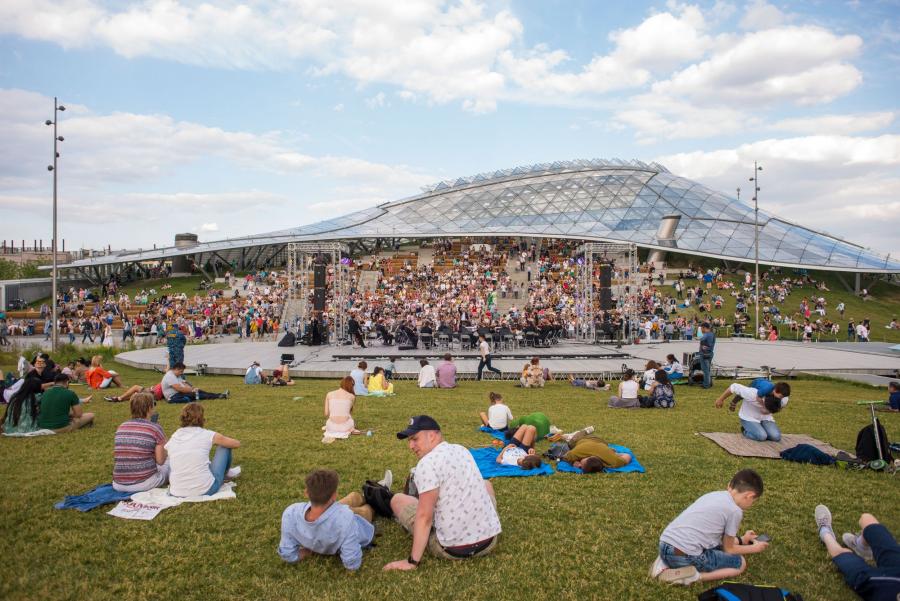
Unique media complexes in the Park "Time machine" and "Soaring", that have no analogues in Russia, invite guests of "Zaryadye" to take a virtual tour to the past, to witness important historical events in the life of the capital and to fly over the main sights of Moscow and the whole Russia.
Visitors of the Park will see the most spectacular views, the best examples of ancient and modern architecture, nature reserves, monuments and parks, the main waterways of the country and experience a real flight. In "Zaryadye" you can as well visit the "Ice cave", Underground interactive archaeological museum, greenhouse complex "Florarium" with soilless plant growing techniques, biotechnological scientific and educational "Nature center". Zaryadye "Hospitality Center" staff will tell you what interesting things can be seen in the pavilions, help you buy tickets and give an informative tour around the park.
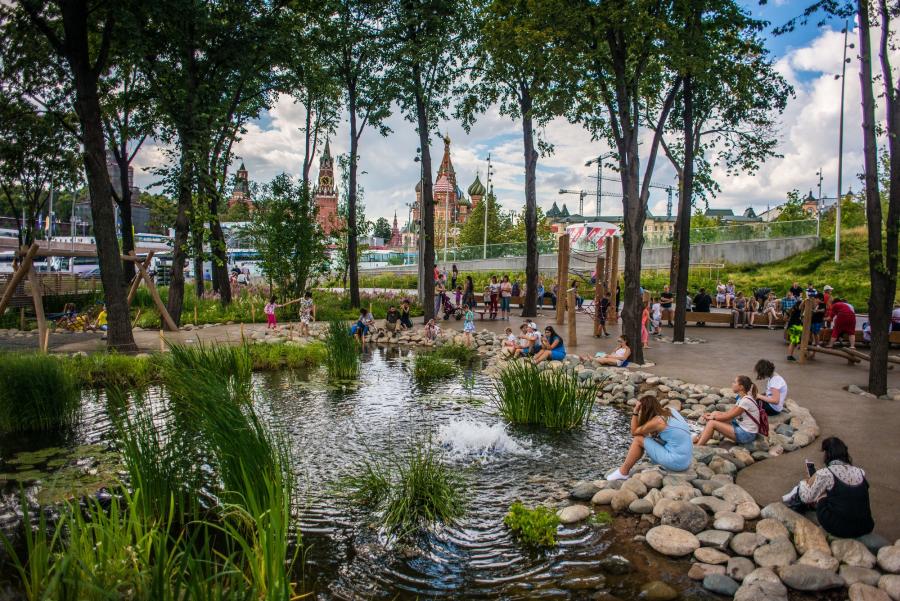
You can take beautiful pictures and selfies in "Zaryadye" on one of the best viewing platforms in the city – the River Overlook, which opens a picturesque view to the Kremlin, the Cathedral of Christ the Saviour, the towers of Moscow city, high-rise on Kotelnicheskaya embankment, the Moscow river and the Park itself.
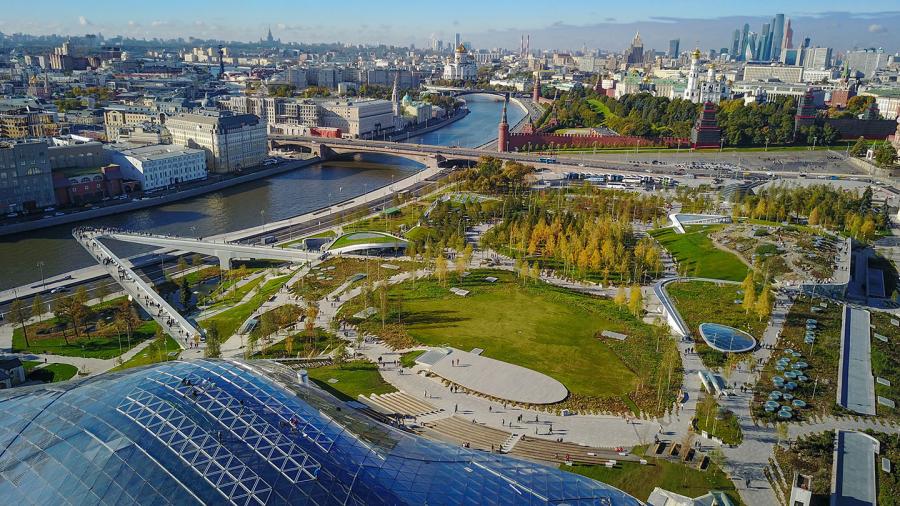
The guests of the Park will also be surprised at another important dominant feature of the Park – one of the biggest open city grounds – a large amphitheater under the unusual translucent structure, the Glass crust, where the air temperature is a few degrees higher than outside.
- Arseny Morozov Mansion on Vozdvizhenka read
- The Melnikov House read

We use cookies to improve your experience on our Website, tailor content, and measure advertising. By continuing to use our Website, you accept our Privacy Policy .
Your request has been sent successfully! Our travel expert will contact you shortly.
This site is protected by reCAPTCHA and the Google Privacy Policy and Terms of Service apply.
Short Breaks at Port Lympne
Book your stay now
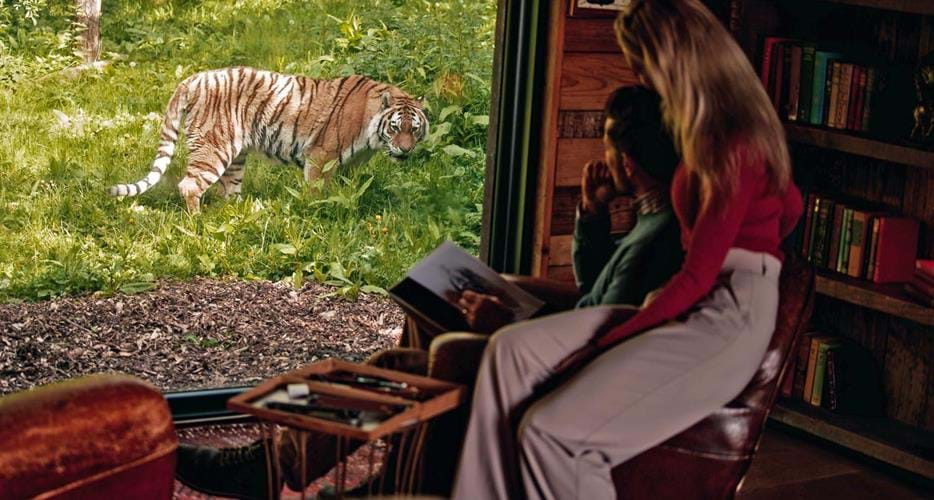
Dream safaris right here in Kent!
Port Lympne’s award winning short breaks range from our luxurious 4* boutique hotel stays to a romantic night under the stars in our 180 degree, panoramic bubble pod. What’s more, you can enjoy your stay knowing that you are directly helping to protect wildlife, with profits from the parks and short breaks supporting our animal conservation charity work that takes place around the world.
Tiger Lodge
Wake up in a tiger’s world, then head out in your own personal golf buggy to meet the rest of the animals in the 600 acre reserve.
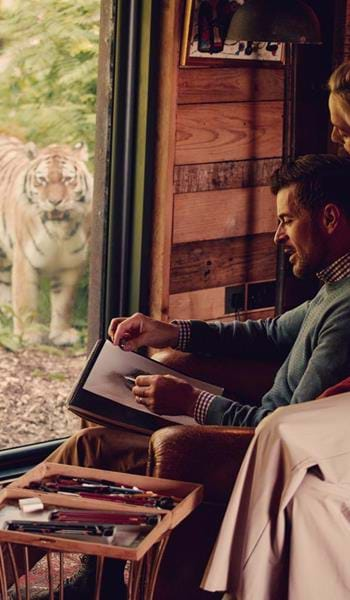
Enjoy stunning views from your award winning self-catering treehouse suite and explore the 600 acre reserve on your own personal golf buggy.

Immerse yourself in the lives of the lion pride at Lion Lodge and explore the rest of the Reserve on your private golf buggy.
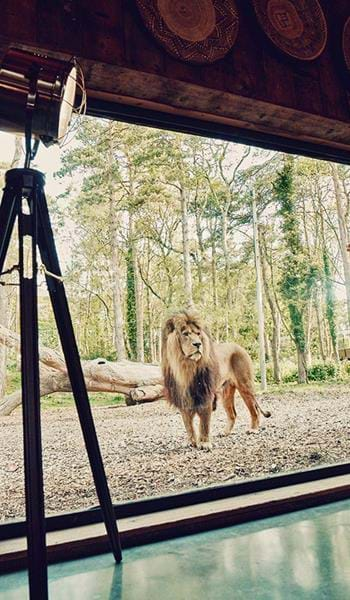
Leopard Creek
Leopard Creek offers luxury accommodation with stunning views of our expertly-designed Amur leopard enclosure.
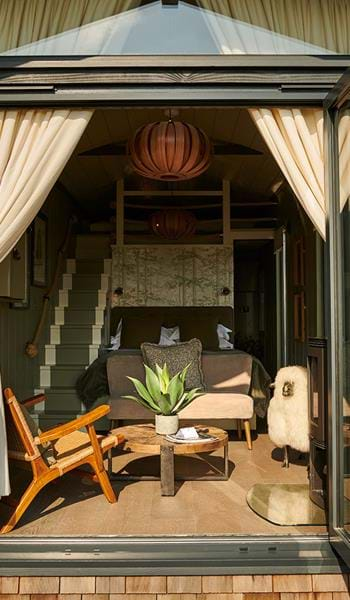
Forest Hideaway
Exclusive hidden forest dens, for the ultimate romantic retreat. Includes a golf buggy to explore the reserve at your leisure.
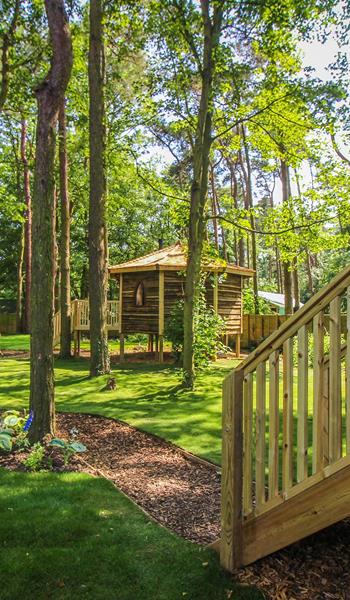
Port Lympne Gift Vouchers
A range of Port Lympne Hotel & Reserve gift vouchers are now available to purchase. Choose from unforgettable short breaks, fun family day drips or decadent dining experiences in the Kent countryside.

Enjoy a unique getaway with all the little luxuries you would expect. Explore our stunning reserve in your personal golf buggy, eat and drink at a variety of restaurants, book additional experiences or simply enjoy nature.
New The Lookout Bubble
Immerse yourself in a luxury romantic retreat, with a spectacular view of the stars. Includes your own personal golf buggy.
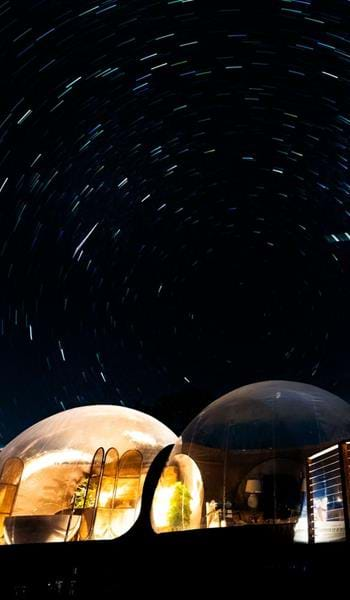
Rhino Lodge
Make friends with your wild neighbours and explore the reserve in your own personal golf buggy.
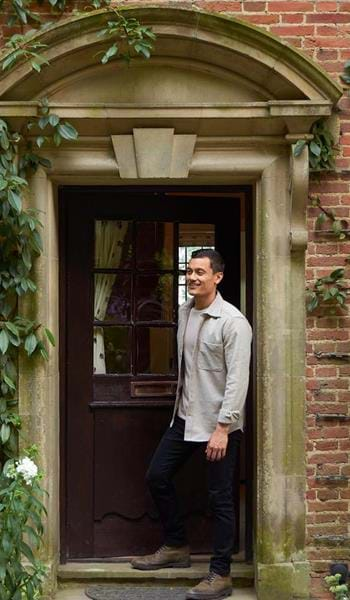
The Treetop Bubble
Immerse yourself in a luxury romantic retreat amongst the treetops, with 180 degree panoramic views. Includes your own personal golf buggy.
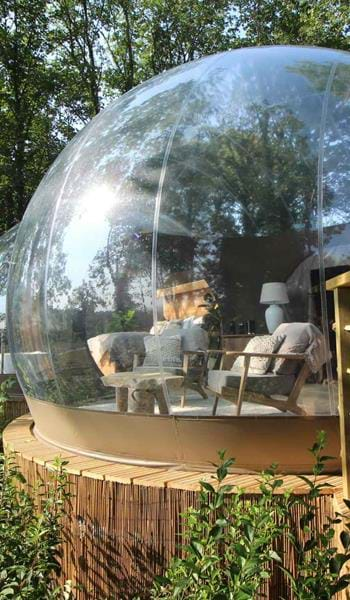
Mansion Hotel
Get away from it all with a stay at our 4* boutique hotel.
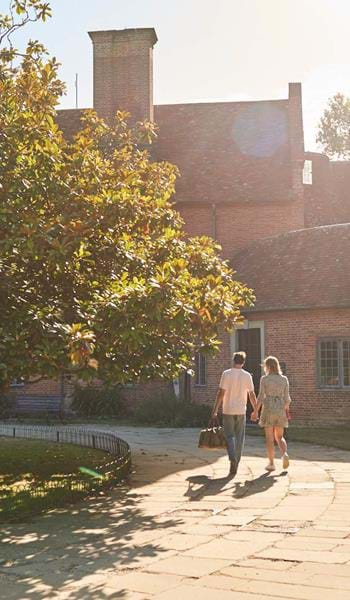
Be part of the pack and watch our wolves from your private viewing window. Then discover over 700 animals as you explore the reserve on your golf buggy.
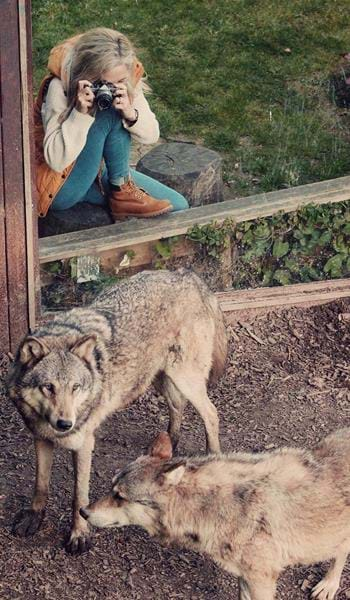
Hog Deer Creek
Stay in the wilds of Kent in your cosy shepherd’s hut. Explore the 600 acre reserve on your own private golf buggy.

Enjoy glamping at its best with family and friends or treat your loved one to a romantic African-style night under the stars!
Put the fun back into camping without the need to pitch a tent at Pinewood, where you can sleep within roaring distance of lions!
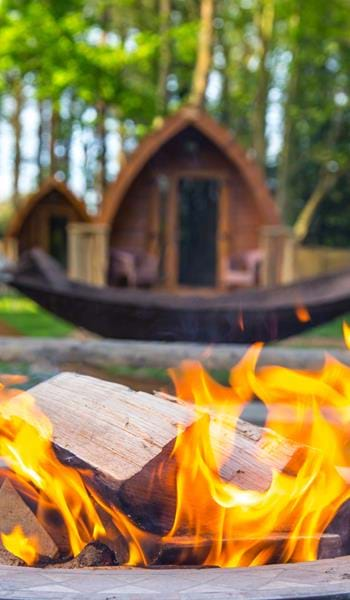
Unforgettable glamping getaway overlooking the spectacled bear habitat. Camp out under the stars and immerse yourself in an exciting safari experience.
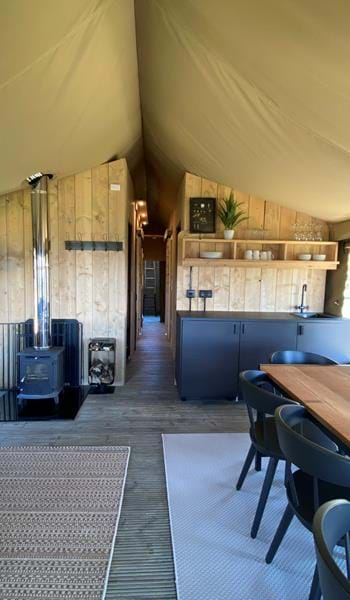
Giraffe Lodge
Camp out under the stars and immerse yourself in an exciting safari experience - right here in Kent!
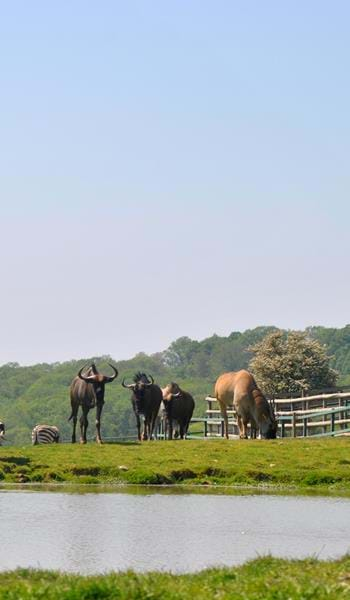
Pinewood - Shepherds Hut
Camp in style and comfort at Pinewood's Shepherd's Hut and fall asleep to the sound of the roaring lions!
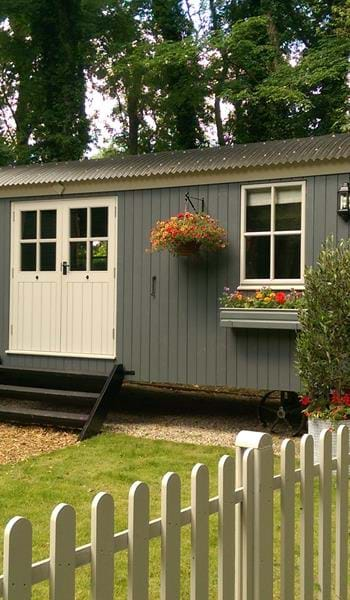
How your stay helps
Simply by enjoying a short break with us, you are directly contributing to the care of the animals in our parks here in the UK and supporting the trailblazing overseas work of our partner charity, The Aspinall Foundation (charity number 326567). Thanks to the generosity of guests like you, The Aspinall Foundation has released more than 75 gorillas, 41 Javan gibbons, 14 Javan grizzled langurs, 125 Javan ebony langurs, 12 European bison, 8 black rhinos and many more animals back to the wild!
Your next adventure awaits
Book a stay at Port Lympne Hotel & Reserve for your next short break and you could find yourselves looking for pirates, setting sail for faraway places, saying hello to all the animals or even discovering lost tribes!
Terms and conditions
Please ensure you have familiarised yourself with our short break terms and conditions.
Share this page

- Port Lympne

IMAGES
VIDEO
COMMENTS
Booking your tickets online in advance is the simplest and quickest way to start your visit. Please note: Carer tickets can be purchased at the Gatehouse on arrival or pre-booked in advance by contacting the team on 01303 264647 or [email protected]. Ticket type. Standard price. Price Including 10% donation.
A truly incredible safari experience. Visit Port Lympne Hotel & Reserve for an unforgettable safari experience set against hundreds of acres of stunning Kentish savannah. There's never been a better time to visit Port Lympne. Bring your family to meet our family! View all tickets and season passes.
29 Mar - 14 Apr. Visit Port Lympne Reserve this Easter holiday from Saturday 1st to Sunday 16th April 2023, to enjoy 'eggstraordinary' big days out! Join us for an authentic safari in the Kent countryside and come face-to-face with giraffes, zebras, rhinos, ostriches and many more incredible species at the Kent's BIGGEST wildlife park. May.
9:30 AM - 6:30 PM. Write a review. About. Port Lympne Hotel & Reserve offers exciting days out in Kent filled with discovery for the entire family. Set in 600 acres, and housing over 650 rare and endangered animals, Port Lympne offers a treat for everyone. Duration: More than 3 hours. Meets animal welfare guidelines.
Port Lympne Hotel & Reserve and Howletts Wild Animal Park's brand-new Annual Pass allows unlimited entry to both parks throughout the year, offering access to over 1,200 animals across 91 species. The Annual Pass also includes access to Port Lympne's iconic safari tours and a terrific 20% discount on food and drink across both parks' many ...
Opening Times. Open everyday except Christmas Day Port Lympne Summer March - October 9.30am - 6.30pm (last entry 3.30pm) Winter October - March 9.30 - 5.30pm (last entry 2.30pm) Howletts Summer March - October 9.30am - 6pm (last entry 4pm) Winter October - March 9.30am - 5pm (last entry 3.30pm) Coaches welcome. Groups welcome.
Adult tickets from £24, was £32. Child tickets from £21 , was £28. Book your admission tickets to Port Lympne Safari Park in Kent and get ready for an unforgettable day out for the whole family. Ticket Information: The time shown on your ticket is the safari truck start time. It is advised to arrive at the park 60 minutes prior to the ...
Half-Price Port Lympne Animal Park Entry, Safari and Digital Adoption Pack. By Dan April 19, 2024 Offers, Zoo and Wildlife Park Offers. See over 900 animals up close and personal with a half-price day out at Port Lympne Animal Park. This fantastic value package also includes a safari experience and a digital adoption pack.
General Admission & Safari Truck Tickets - Port Lympne Safari Park. Get your tickets to a safari truck ride at Port Lympne Safari Park in Kent for 25% OFF and see extraordinary animals from around the world today. Available to 31 December 2024. Book now from £24.00.
28 Sep, 2023. Port Lympne Reserve, located in Kent, England, is a renowned wildlife conservation and safari park that covers approximately 600 acres of stunning countryside. Established in the 1970s, the reserve is famous for its mission to protect and rehabilitate a diverse range of wildlife species from all over the world.
Port Lympne is home to Kent's only giraffes and spectacled bears. Gorilla feeds are a real highlight of any visit and take place at 12 and 3 pm. They also have a Dinosaur Forest that is the UK's largest outdoor dinosaur exhibition. The reserve covers 600 acres and is home to more than 760 animals from over 90 species.
See the reserve from one of our game viewing land rovers on this 2.5 hour safari. Enjoy the South American, Asian and African experiences whilst guided by one of our expert Rangers who will tell you everything you ever wanted to know about the animals who wander freely in these areas. Subject to the animals' behaviour on the day, you may even ...
Make your visit to Port Lympne Reserve even more special by booking one of our unforgettable experiences. Whether you prefer a safari adventure across our unique Kentish savannah, a delicious dining experience or the chance to feed your favourite species, there's something for everyone to enjoy at Kent's biggest wildlife park.
The Beaches - New Beach. Dymchurch (2.7 miles from Port Lympne Wild Animal Park) Located in Dymchurch in the Kent region, The Beaches - New Beach features a patio. This property offers access to a balcony, free private parking and free WiFi. Show more.
Port Lympne Mansion Hotel. Port Lympne Hotel & Reserve, Aldington Road, Hythe, CT21 4PD, United Kingdom - Excellent location - show map. 9.0. Superb. 178 reviews. Very good breakfast, beautifully cooked and presented. Christopher United Kingdom. The mansion is beautiful and staff were really helpful and friendly.
Review: Going on Safari at Port Lympne Wildlife Park. By My Tunbridge Wells 26/05/2019. We visited Port Lympne Wildlife Park during the Easter Holidays and loved spending the day exploring the home of over 700 rare and endangered animals! The safari experience is so unique and something we haven't come across anywhere else in the UK.
We went along to Port Lympne Wild Animal Reserve to check out the safari experience in the 'Kent Serengeti' as well as Dinosaur Forest and other awesome animals throughout the park. After entering Port Lympne which is located on over 600 acres of Kent countryside, we were advised that the best way of seeing everything was going straight ...
Explore the world with Booking.com. Big savings on homes, hotels, flights, car rentals, taxis, and attractions - build your perfect trip on any budget. ... State Park 21 properties; Ocean City Boardwalk 765 properties; Niagara Falls State Park 75 properties; Disneyland 247 properties; O2 Arena 14,509 properties; Portmeirion 9 properties;
Explore the world with Booking.com. Big savings on homes, hotels, flights, car rentals, taxis and attractions - build your perfect trip on any budget. ... Niagara Falls State Park 76 properties; Kalahari Waterpark Resort 43 properties; Disneyland 247 properties; Times Square 1,382 properties; Burj Al Arab 4,291 properties;
Reviews — Zoos in Europe. Moscow Zoo. During the second half of the nineteenth century the first menageries in Moscow were established as entertainment facilities. The first was founded in 1855 by two Frenchmen (names unknown), while the Kreuzberg family owned a private menagerie that opened its door to the public in ...
For a full list of what is included with each accommodation please see our short breaks pages. If you have any questions please contact our Short Breaks team on 01303 234112 or email us. Make your short break even more special by booking activities and experiences to fill your days with once in a lifetime encounters and photo opportunities.
Zaryadye Park is a new symbol of Moscow. Being located in the very heart of Moscow, next to the Kremlin walls, Zaryadye Park is not just an ordinary park. It is a cultural and educational center with a unique botanical collection of plants taken from some nature zones of Russia (forest, steppe, meadow and northern landscape), that comprises ...
Dream safaris right here in Kent! Port Lympne's award winning short breaks range from our luxurious 4* boutique hotel stays to a romantic night under the stars in our 180 degree, panoramic bubble pod. What's more, you can enjoy your stay knowing that you are directly helping to protect wildlife, with profits from the parks and short breaks ...